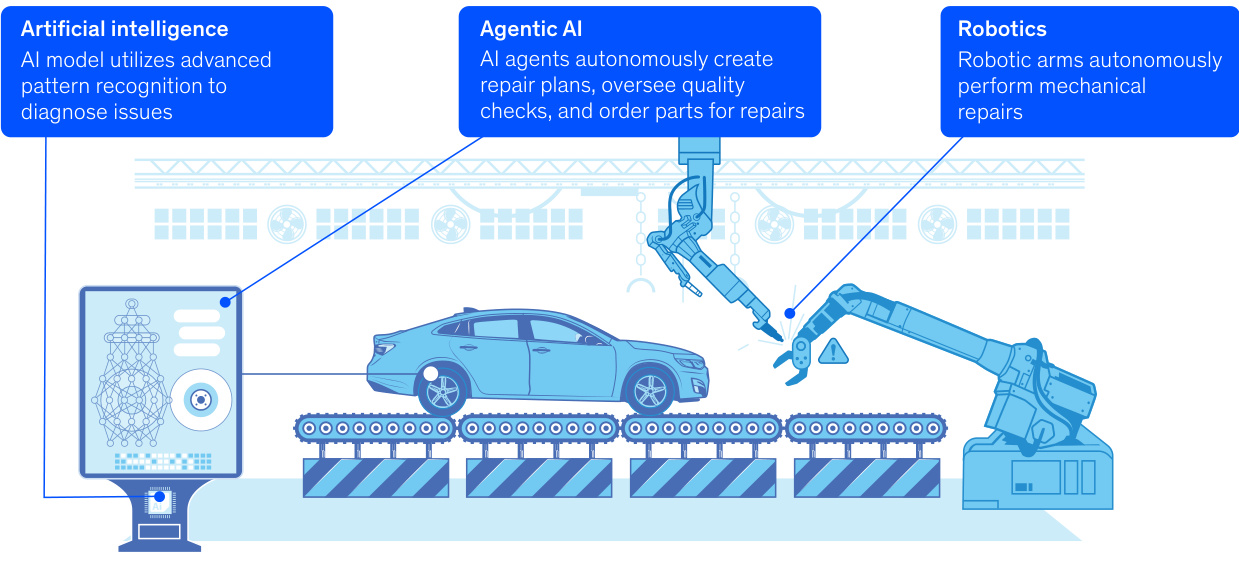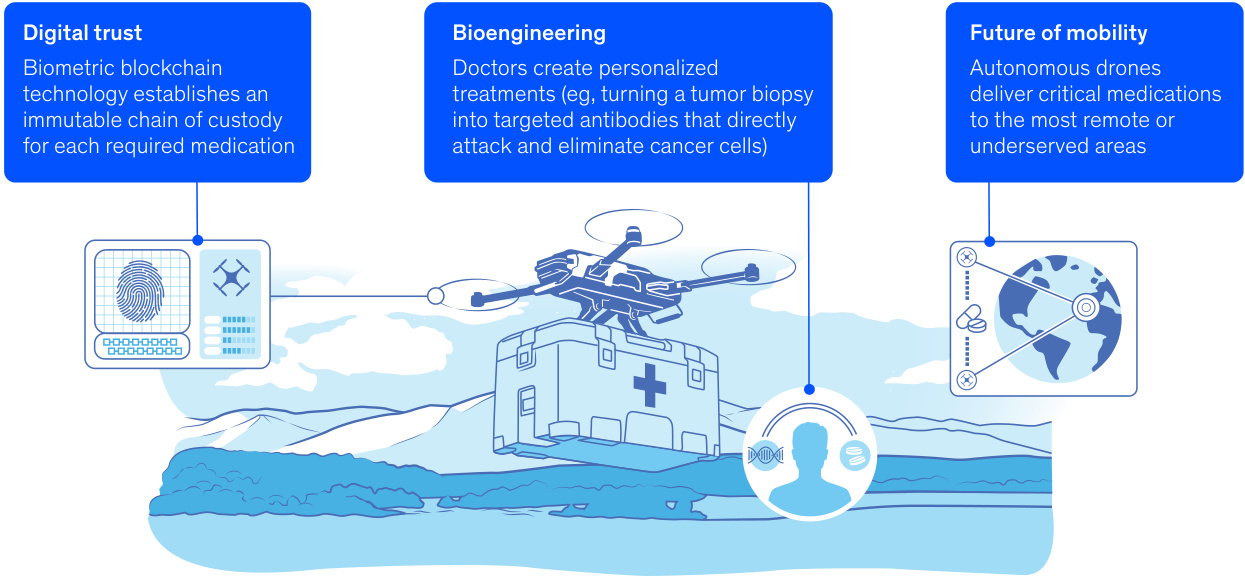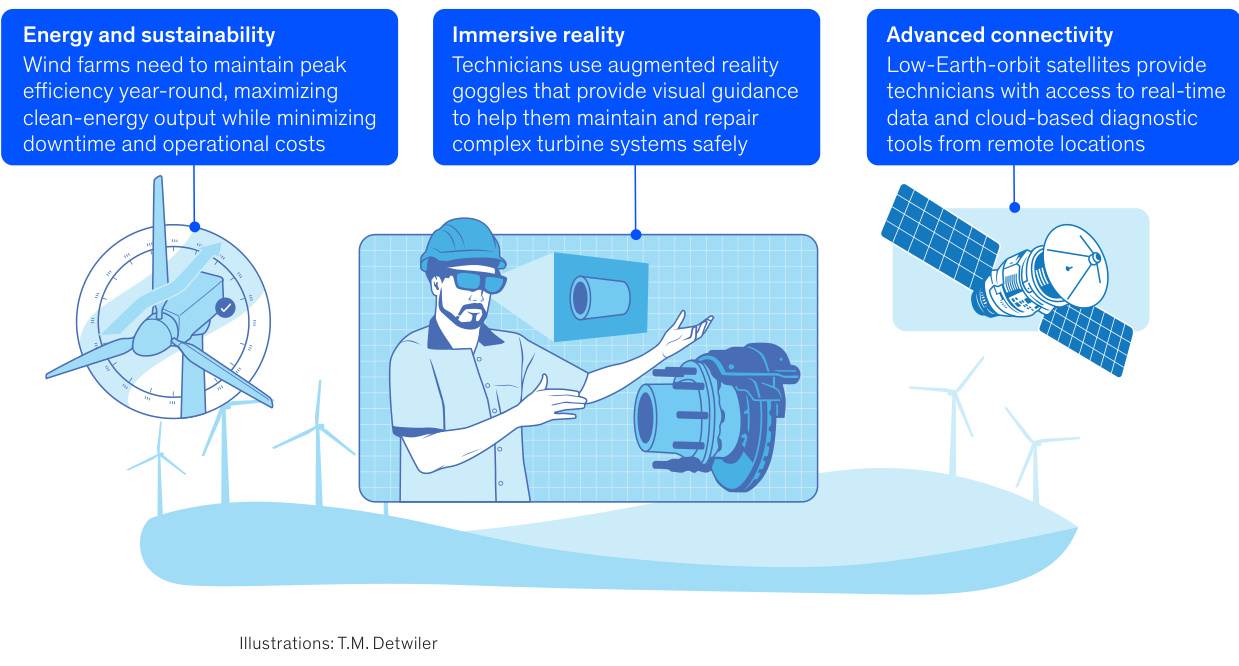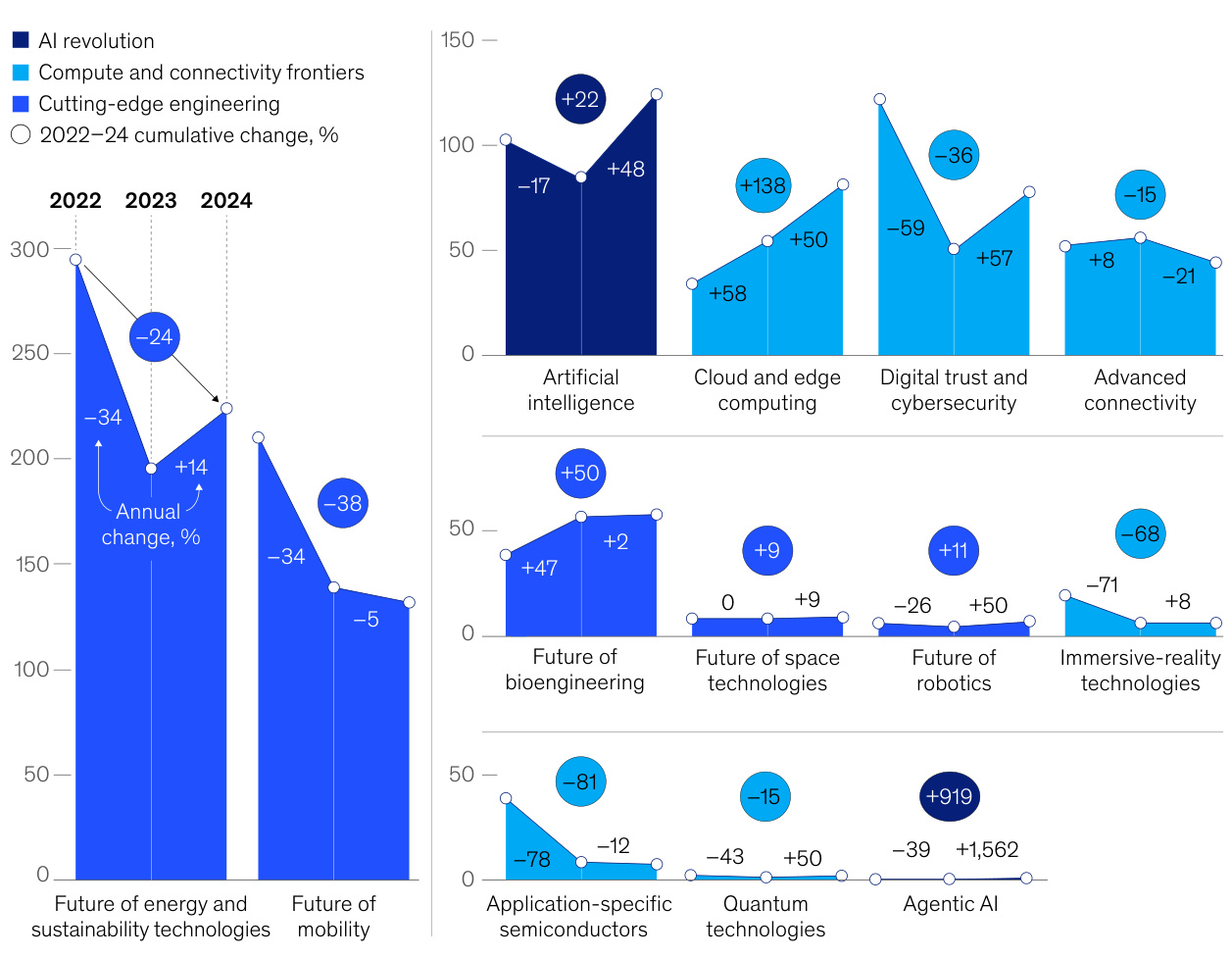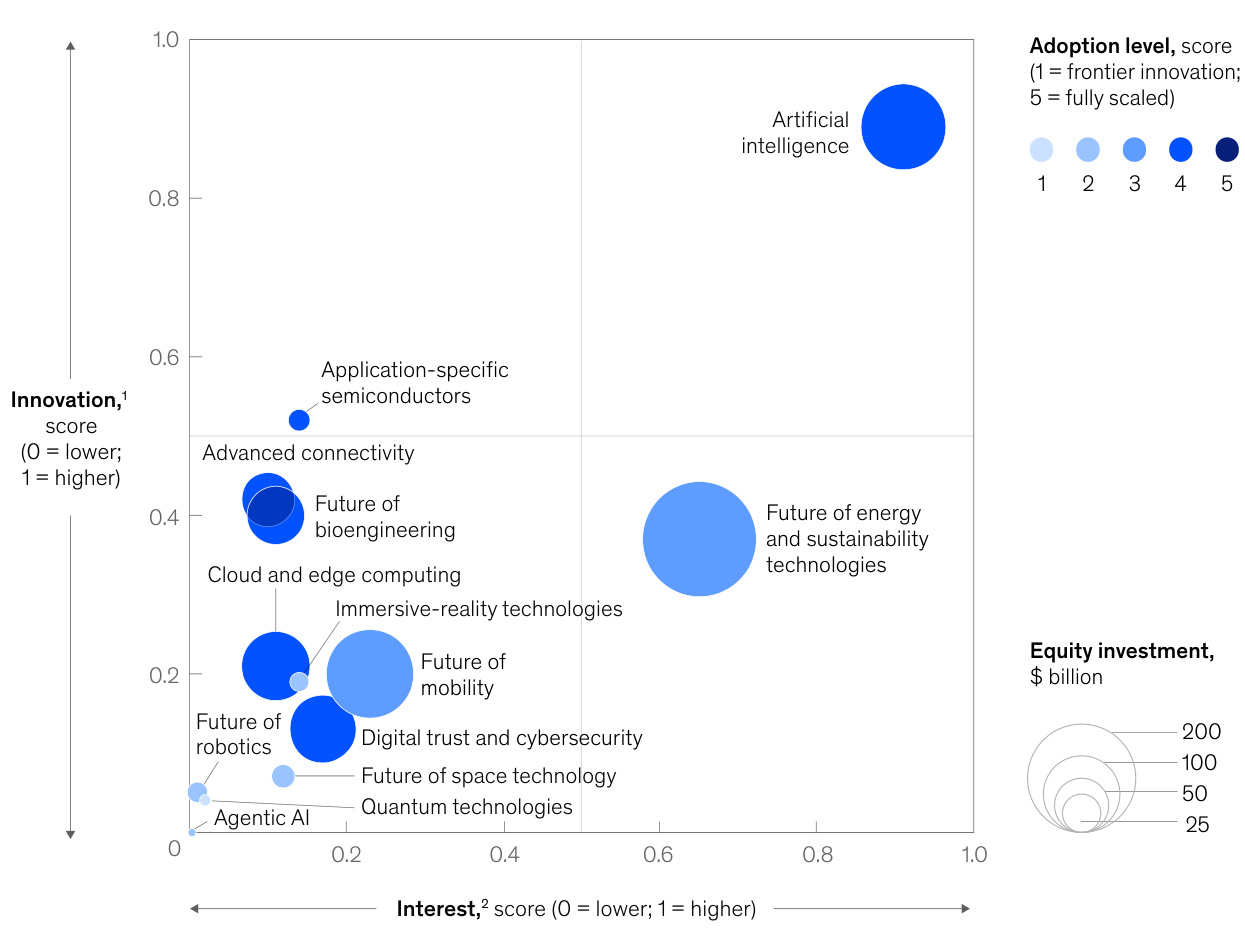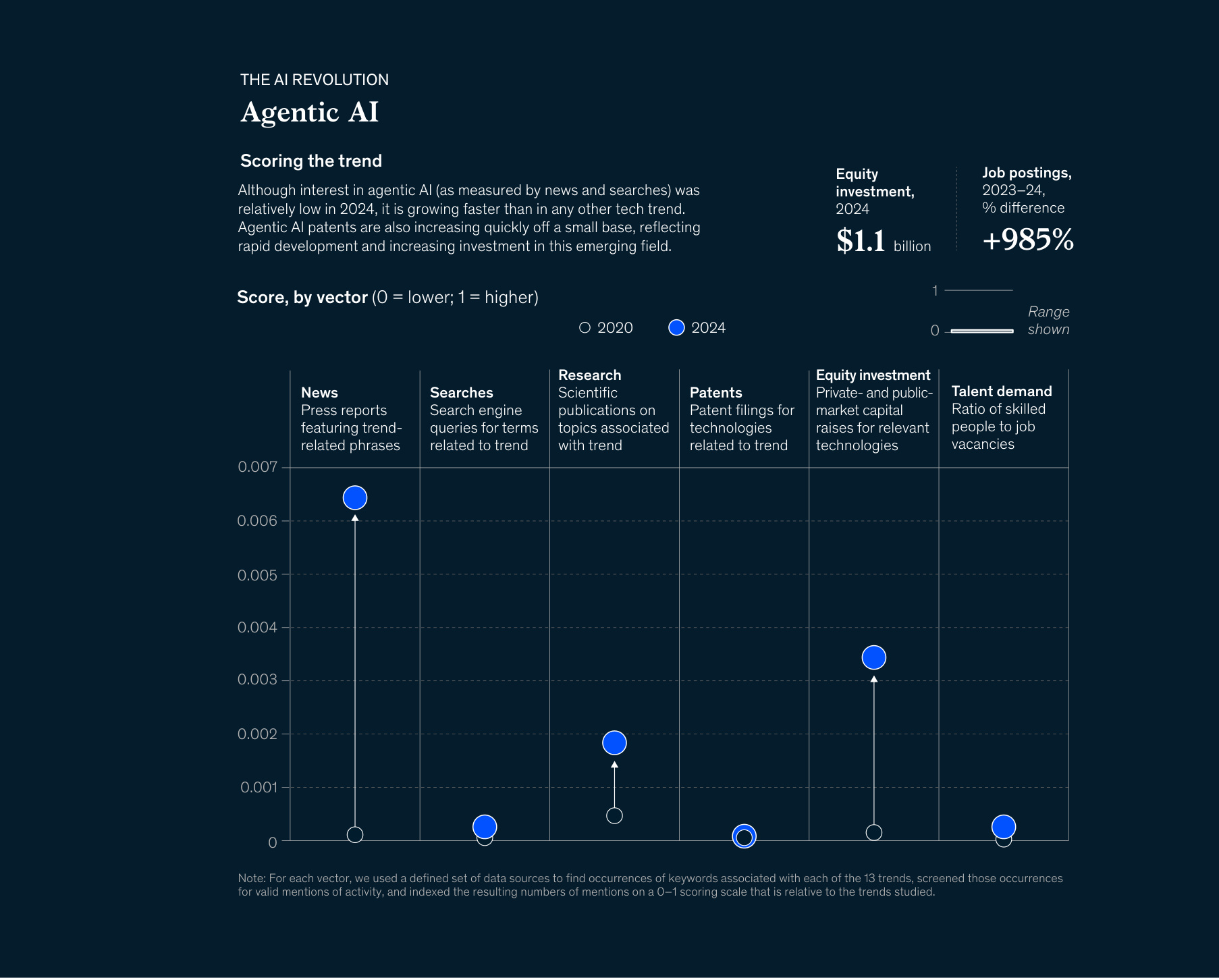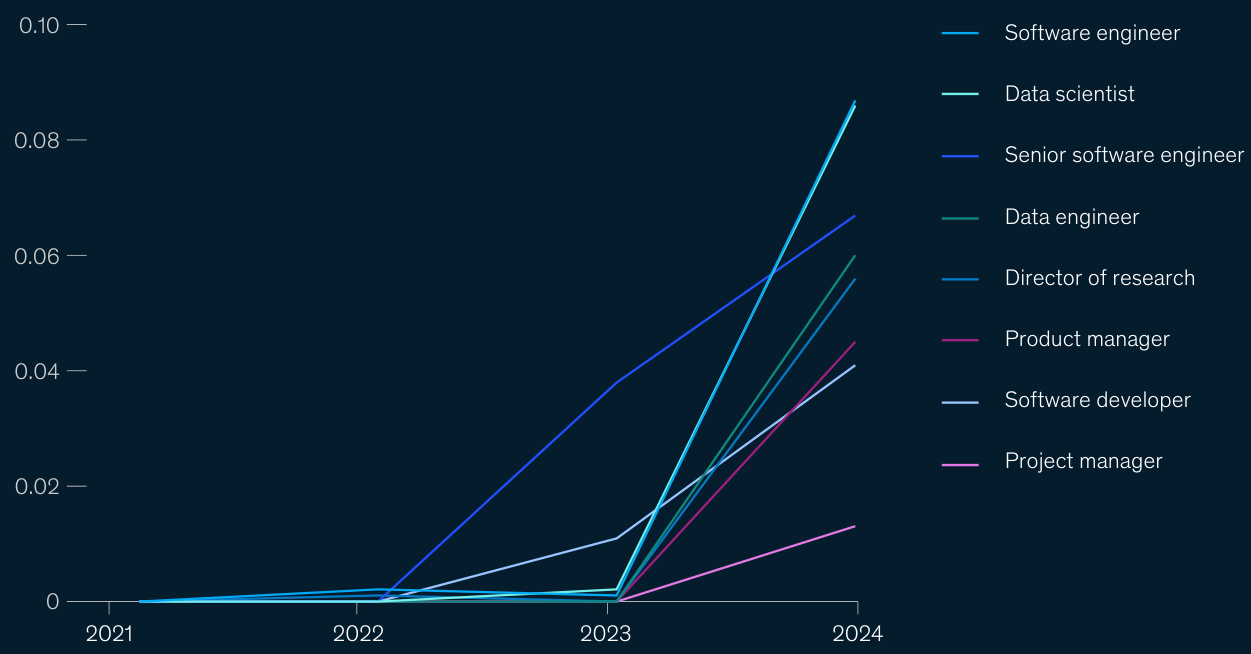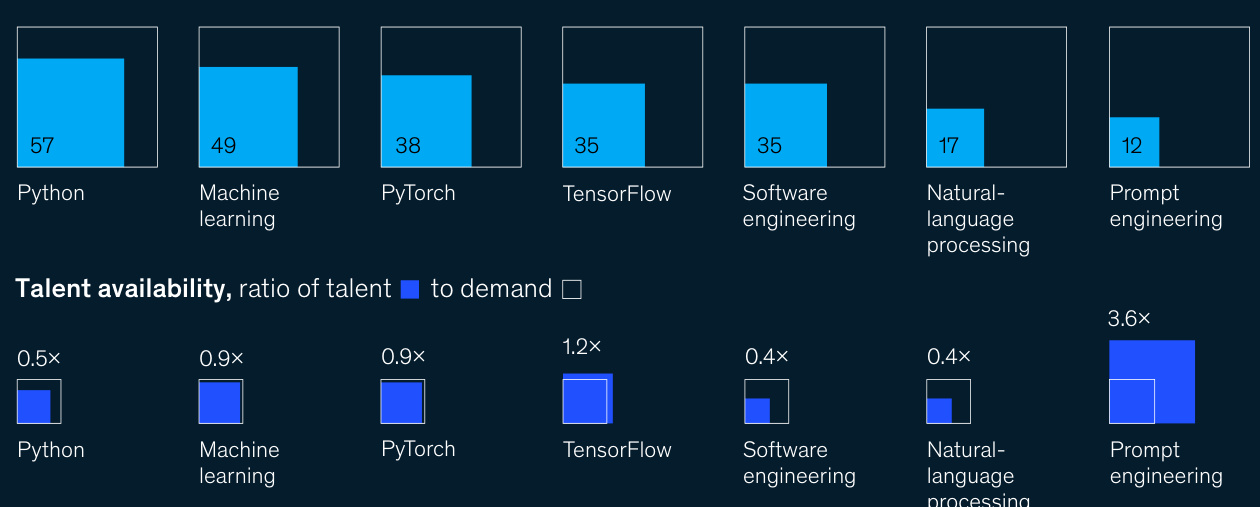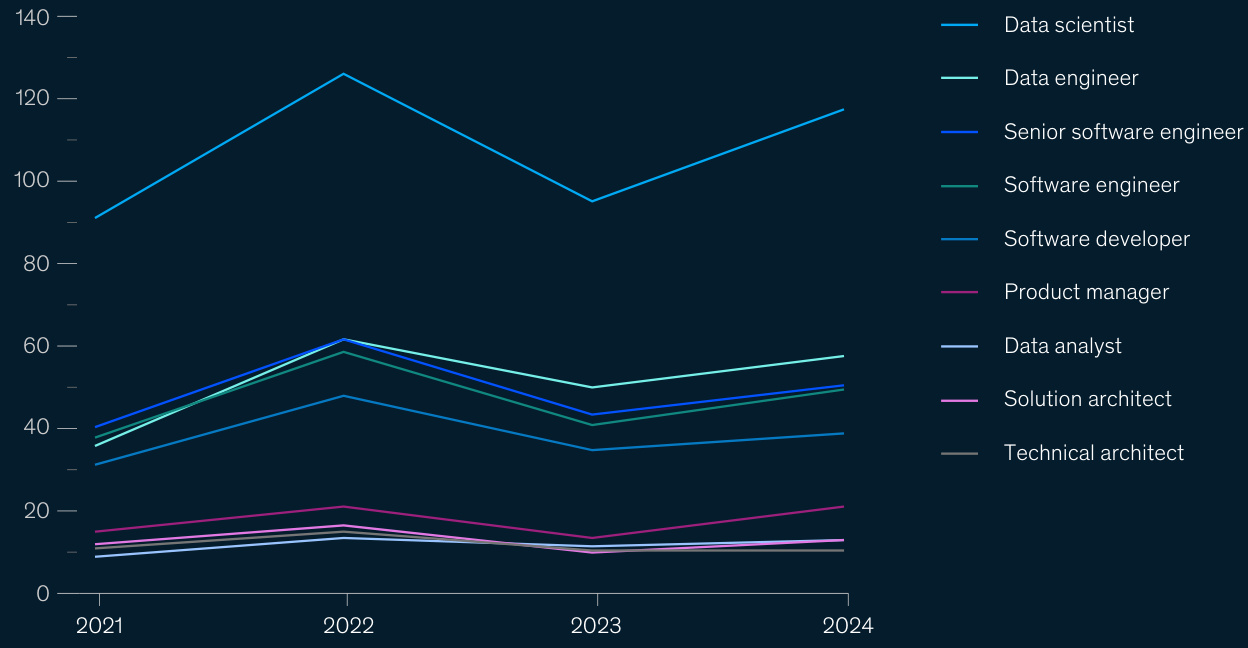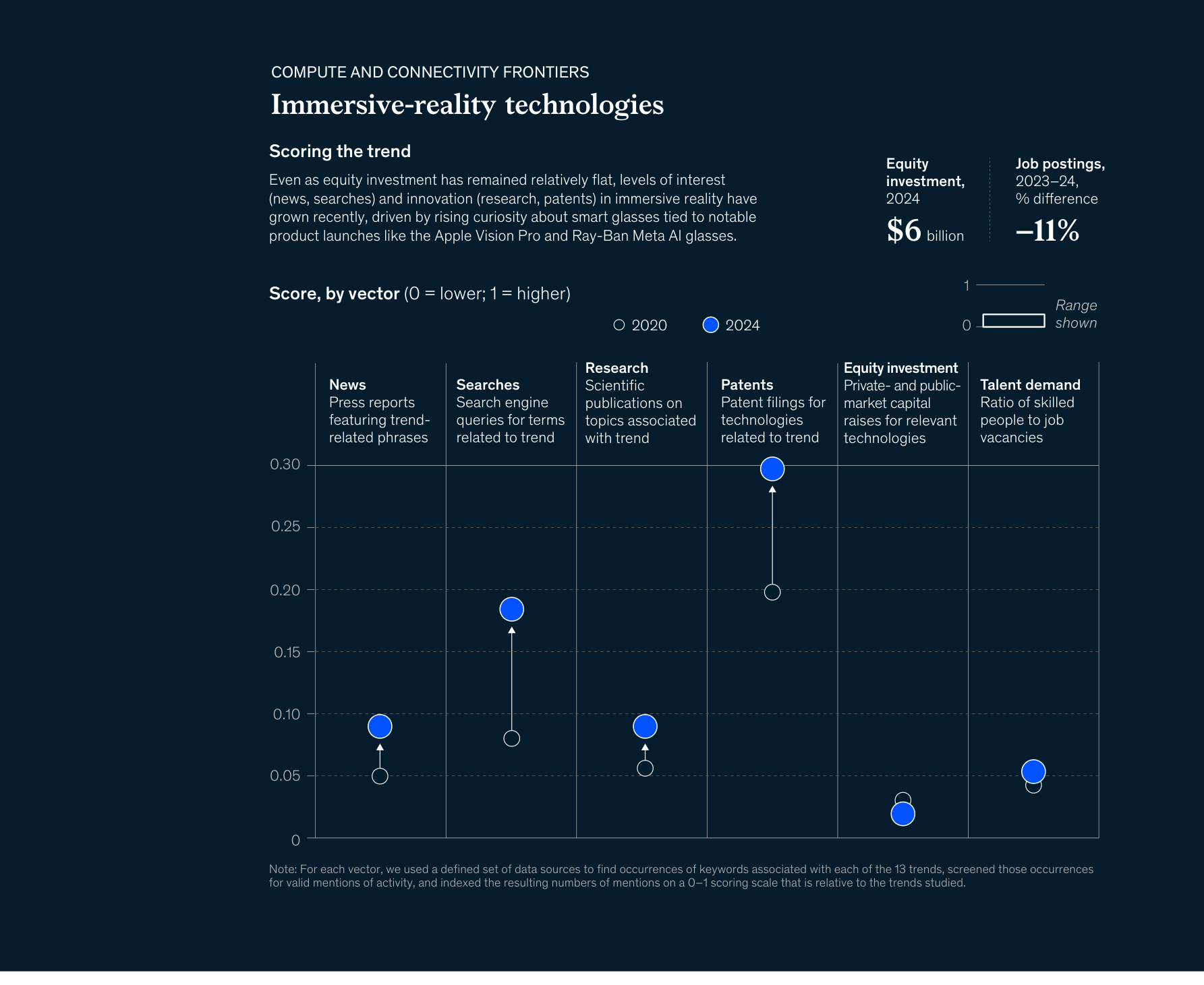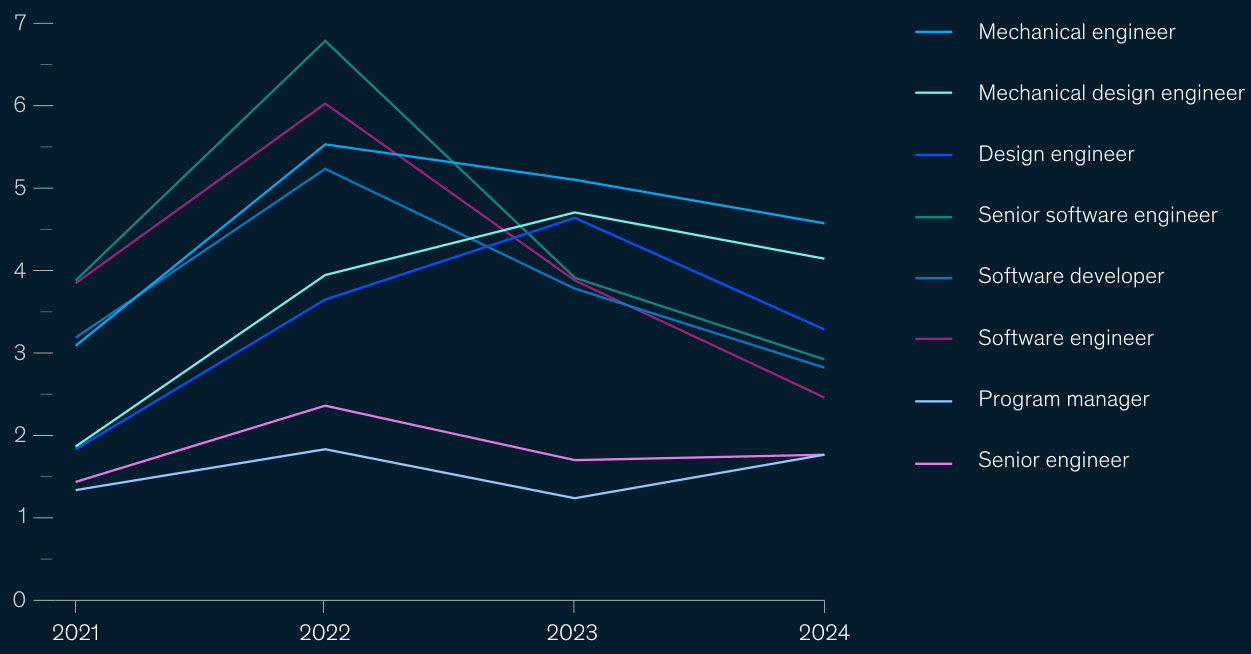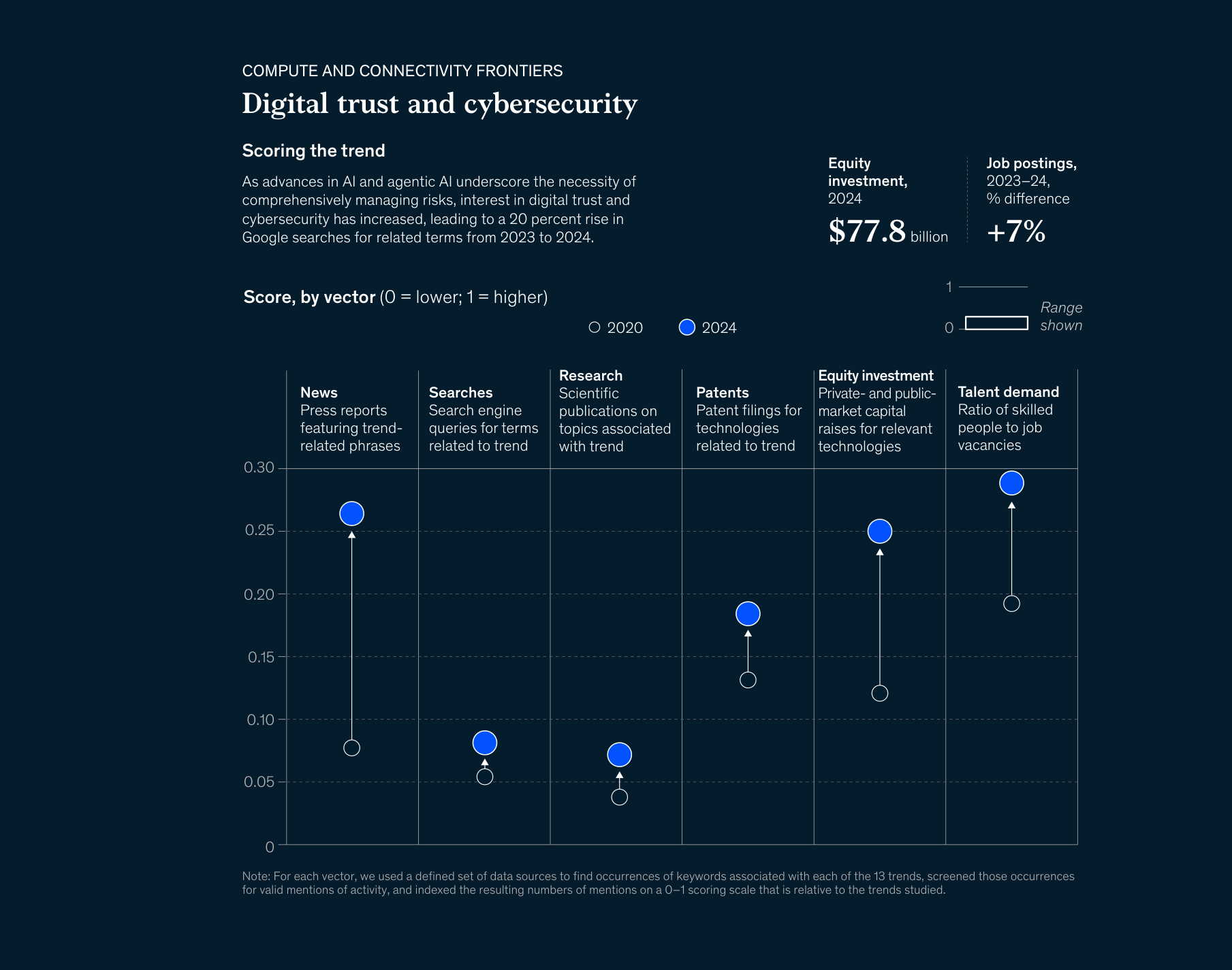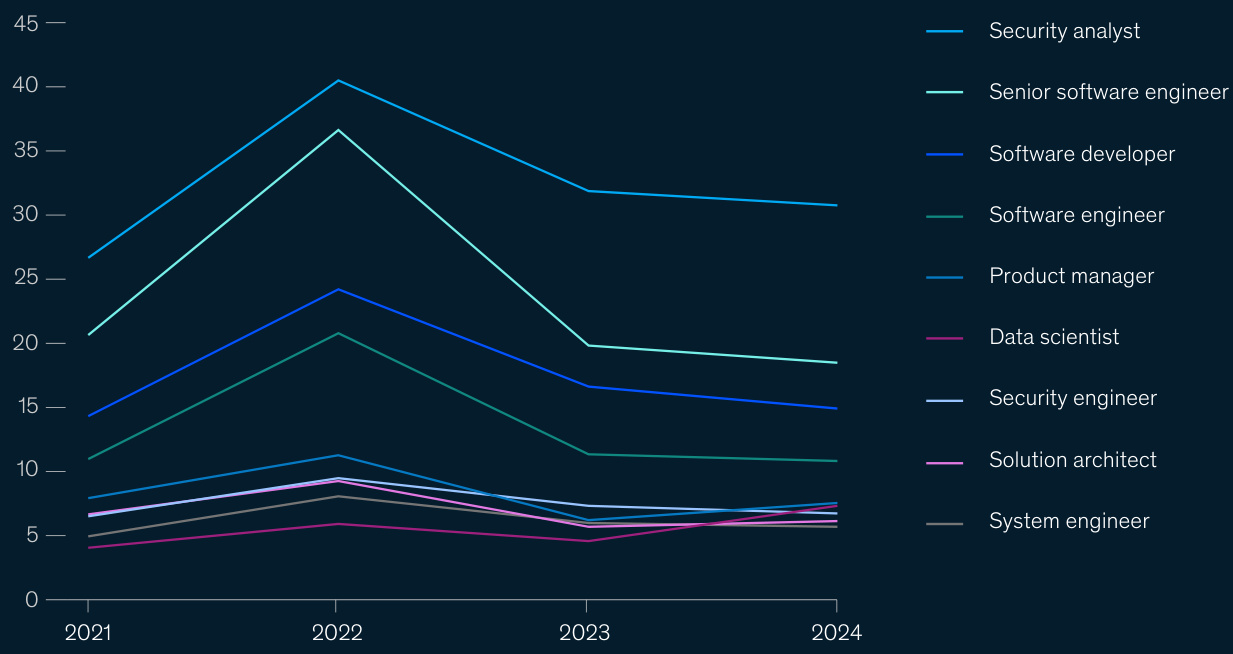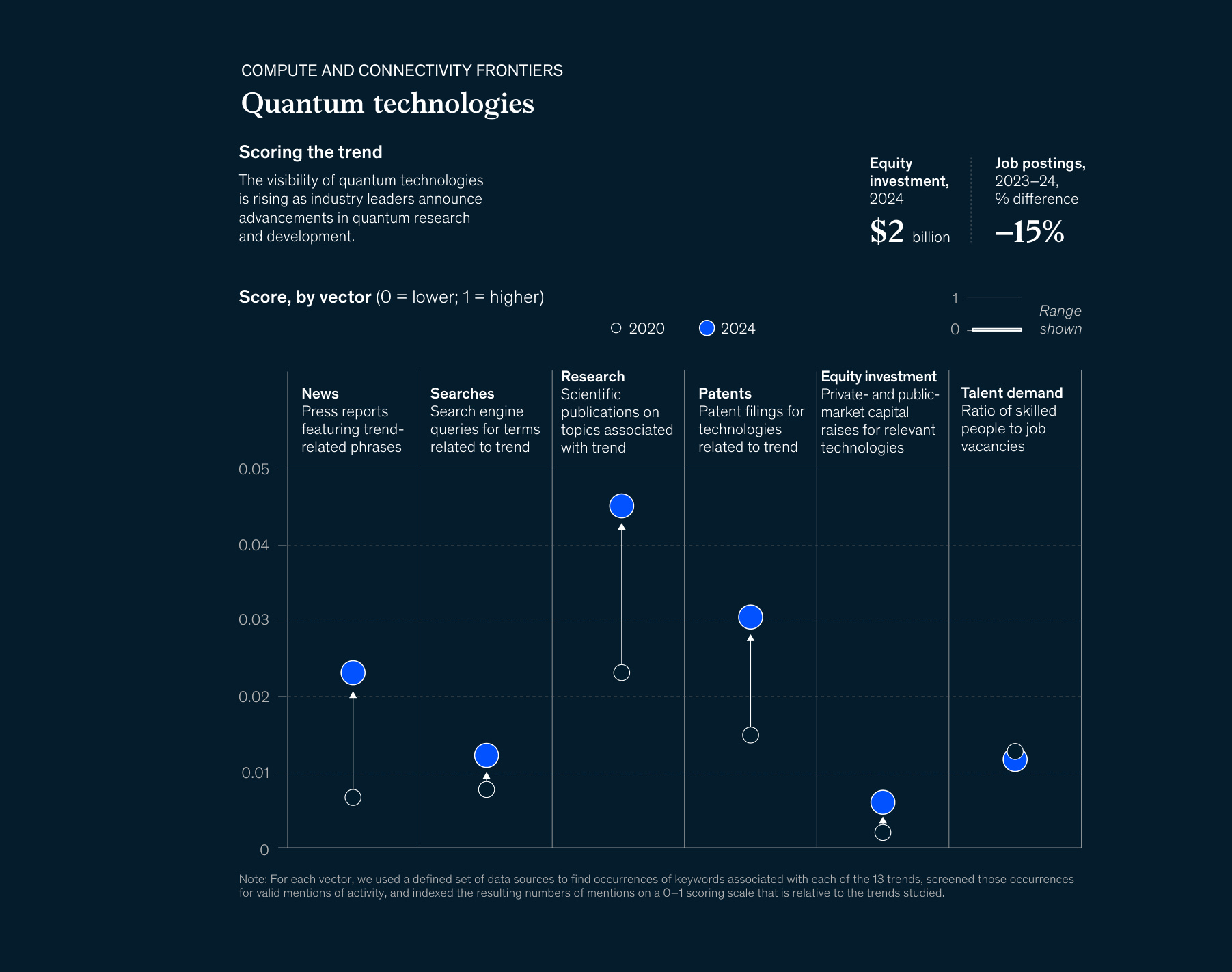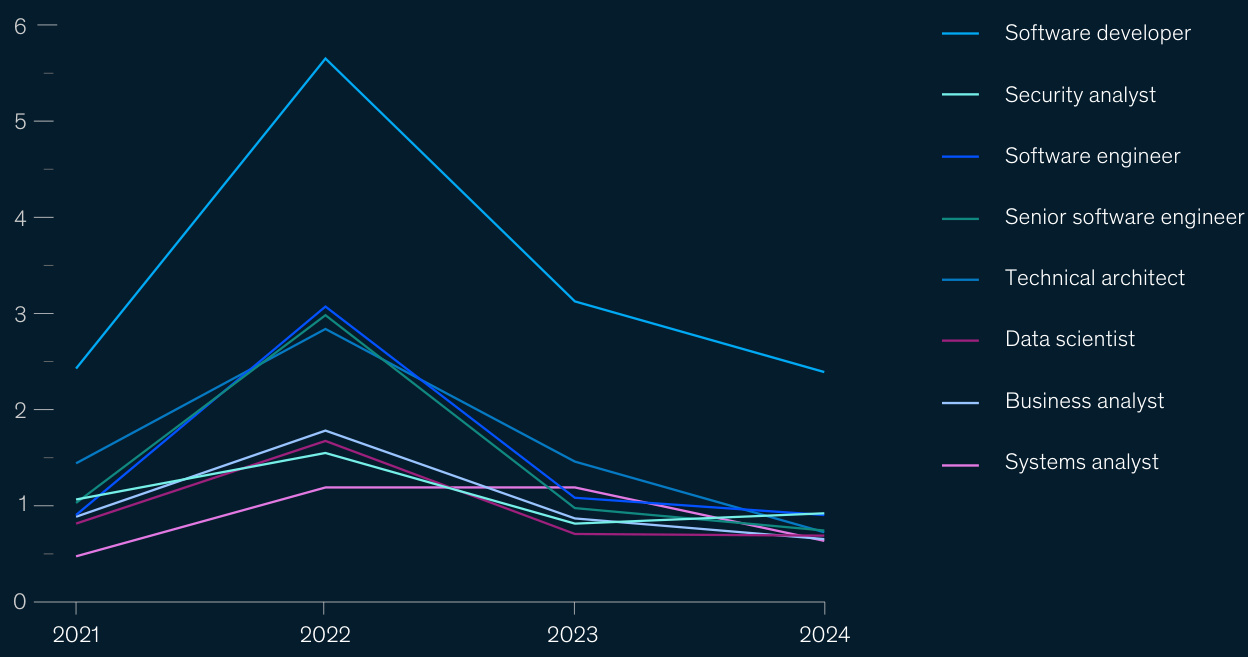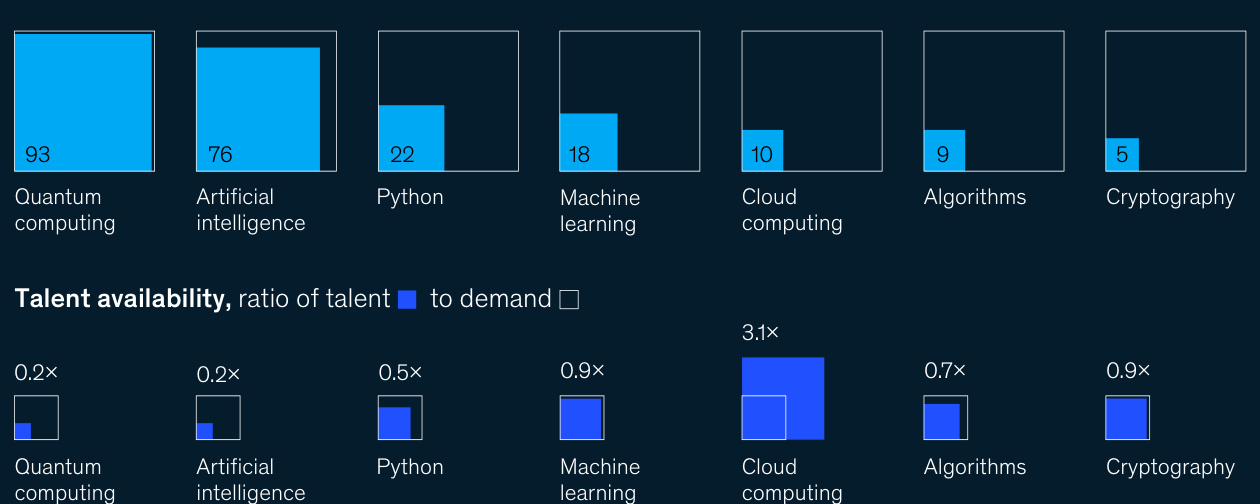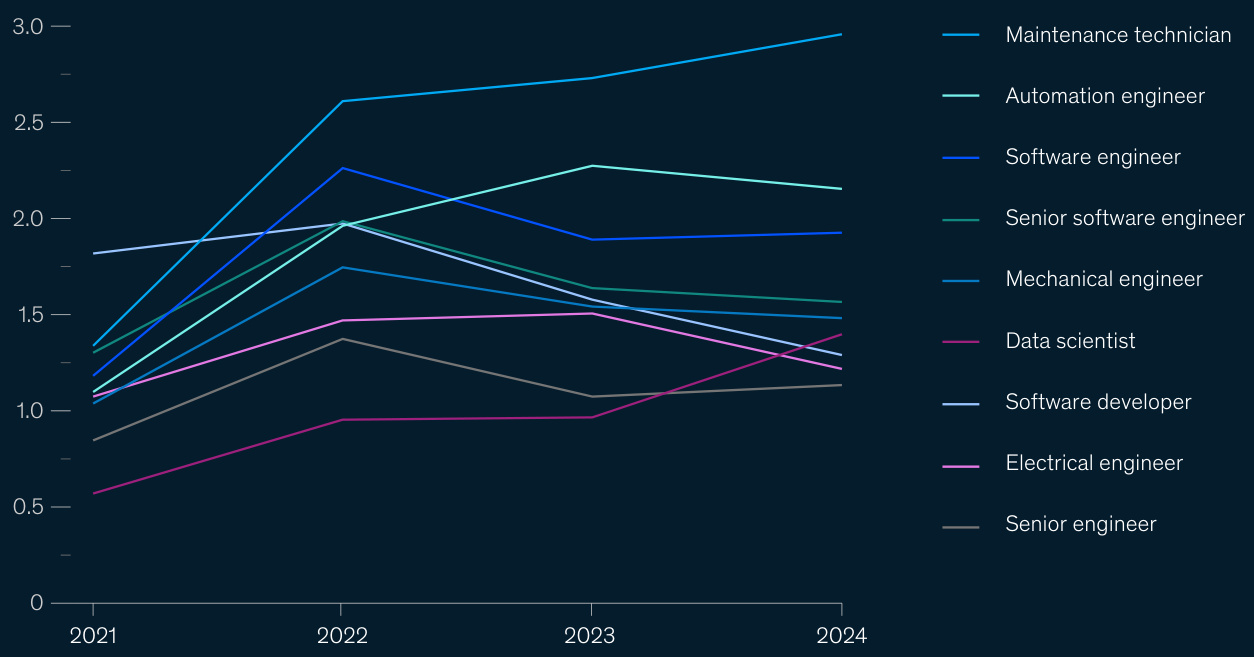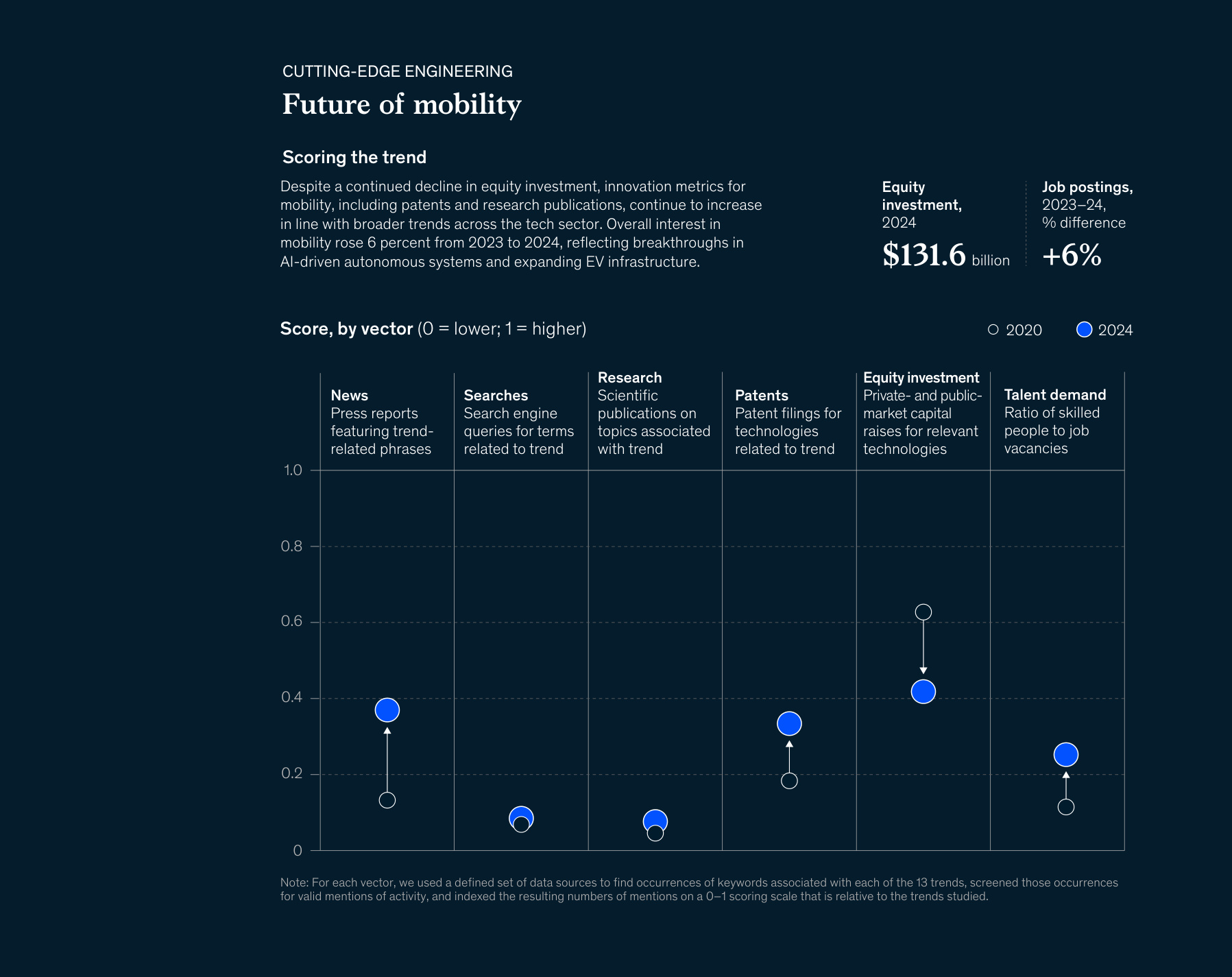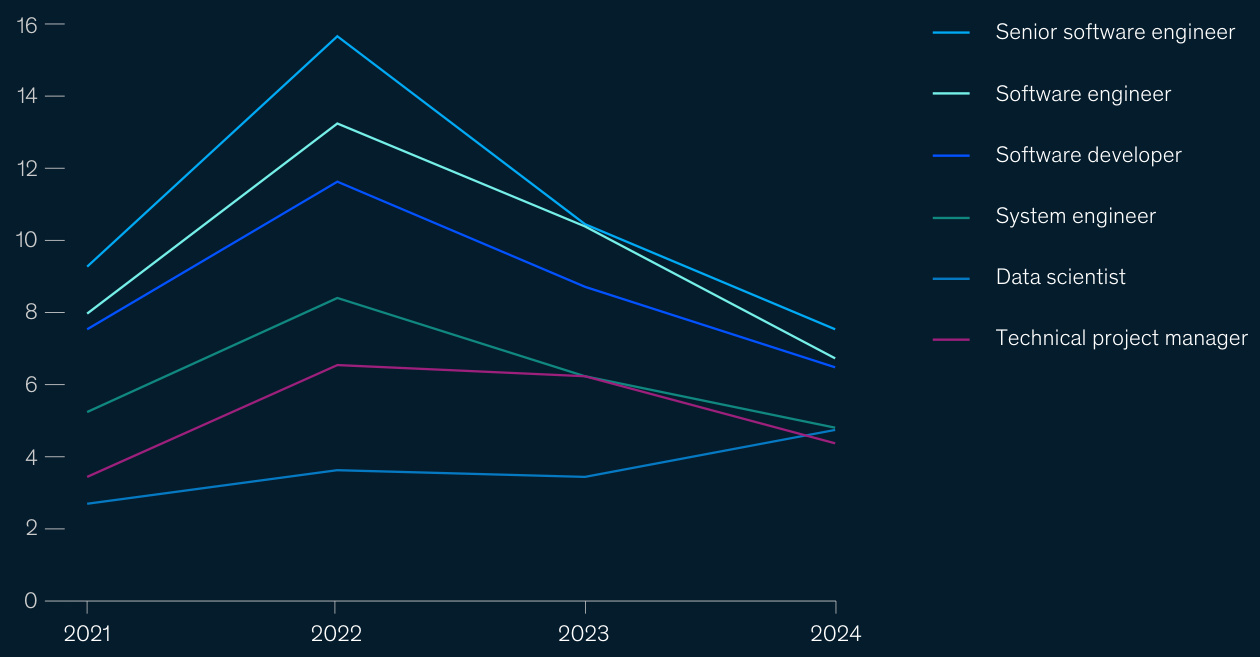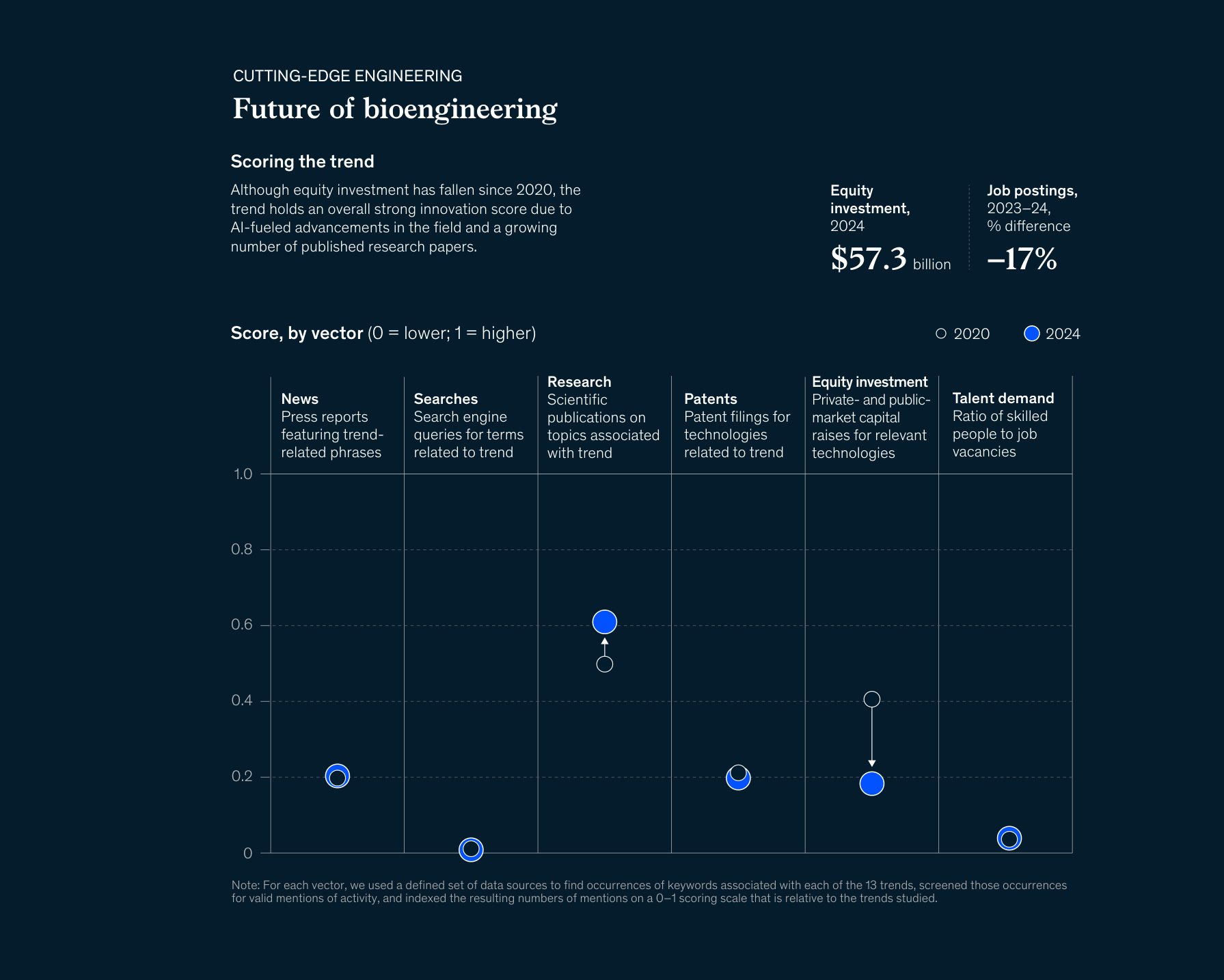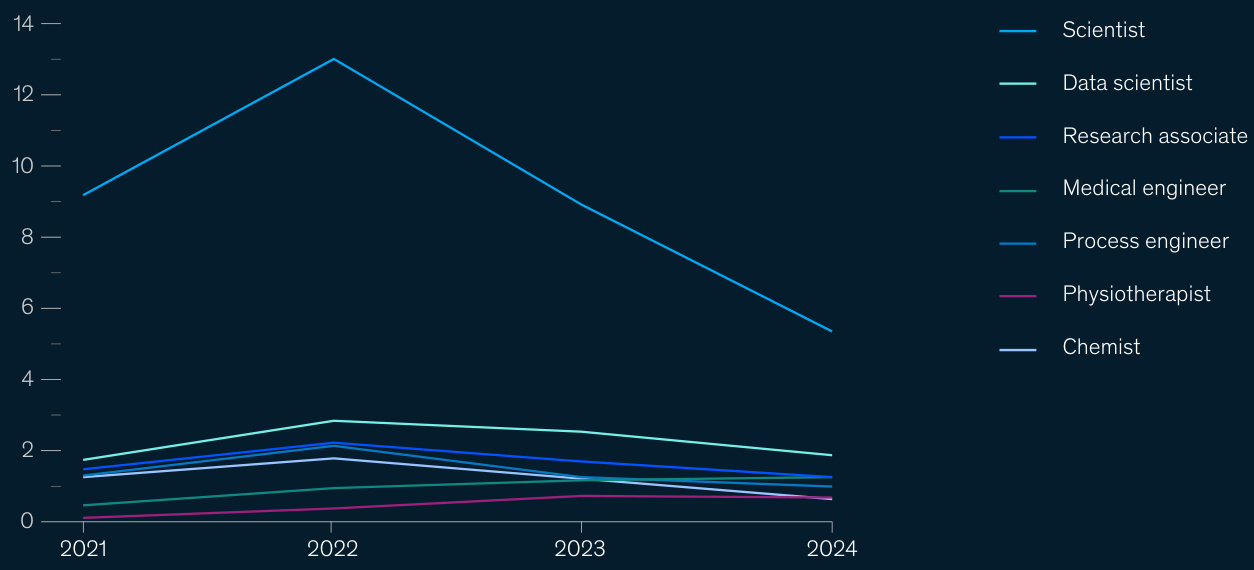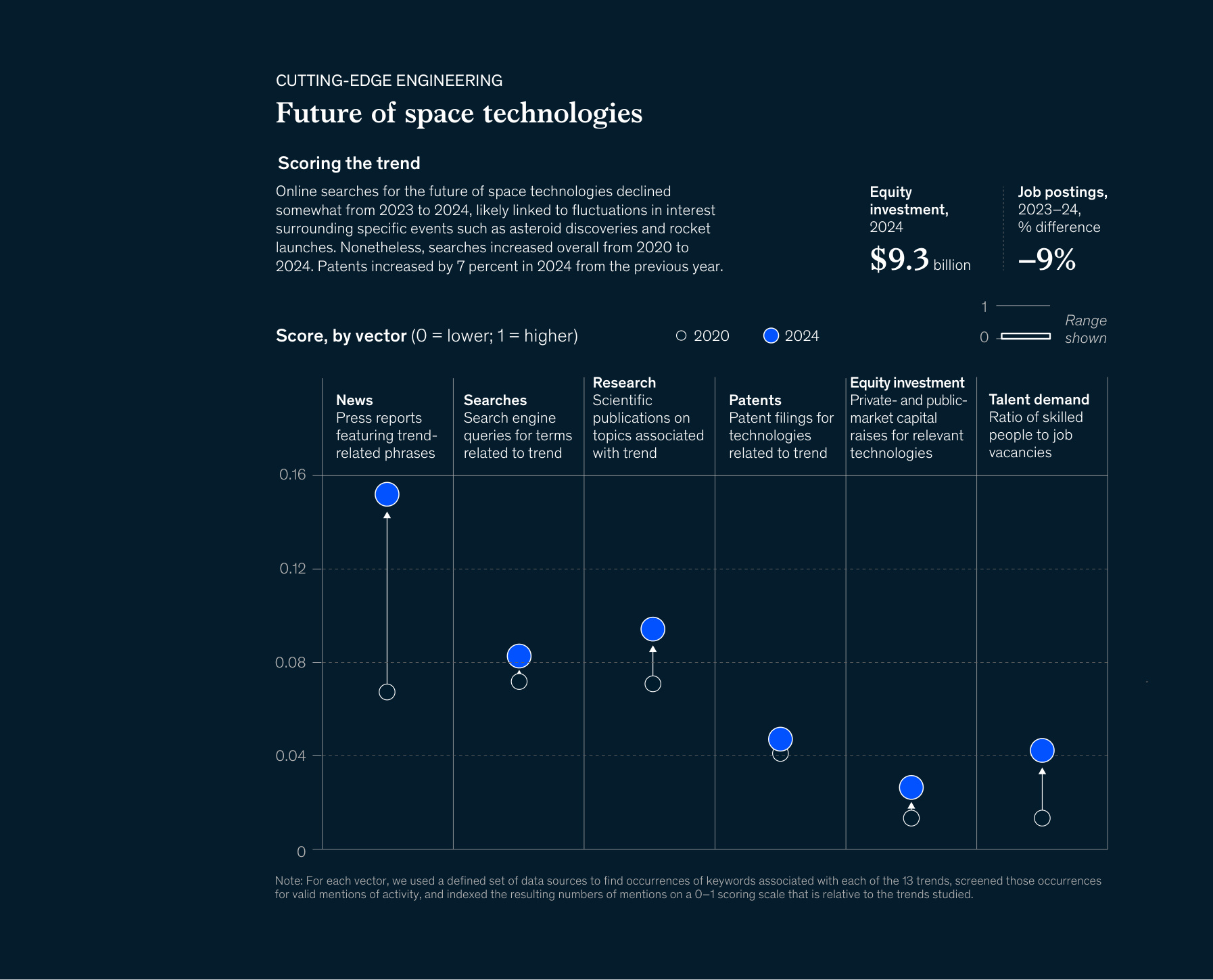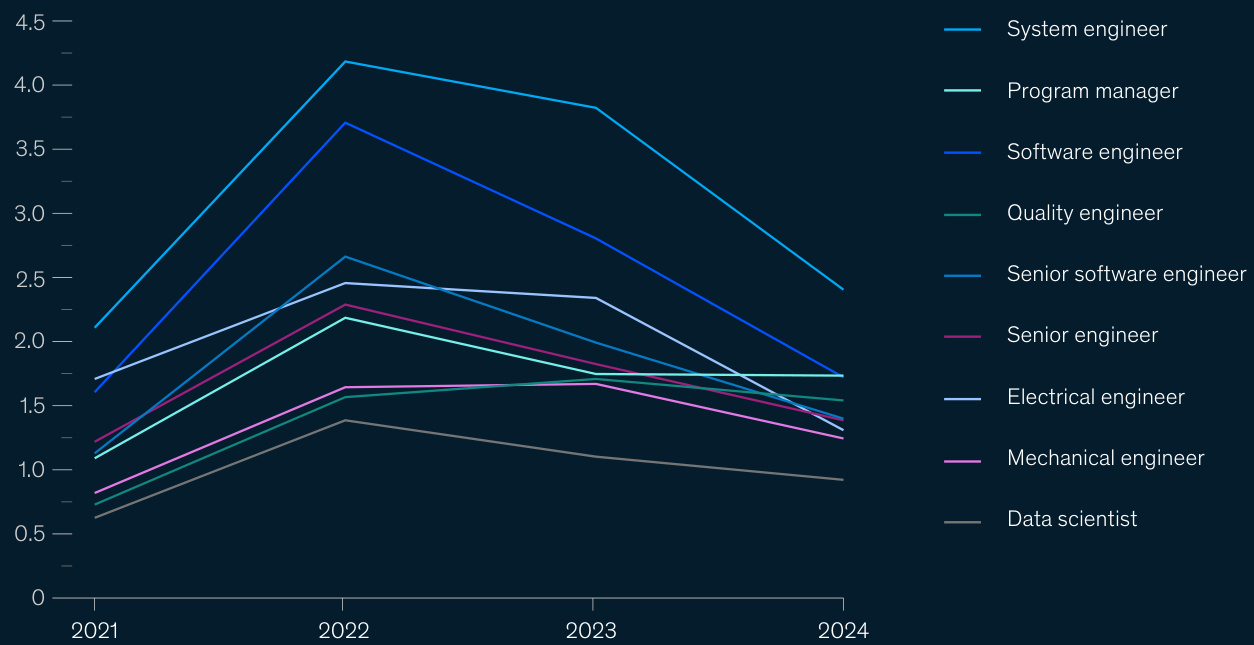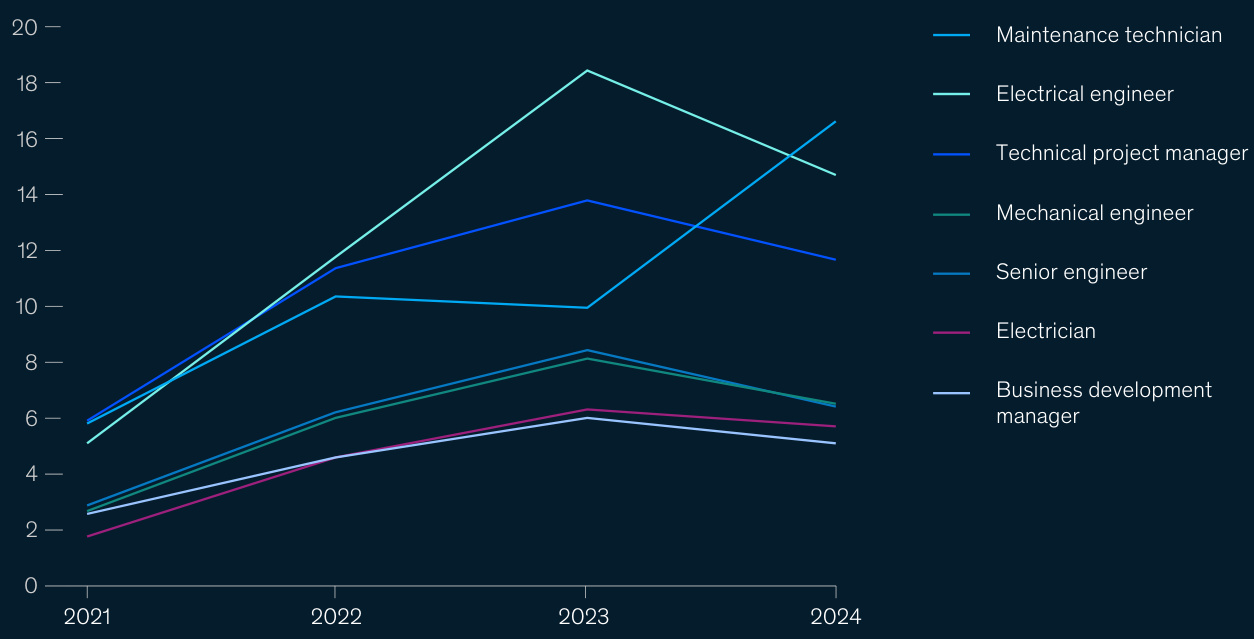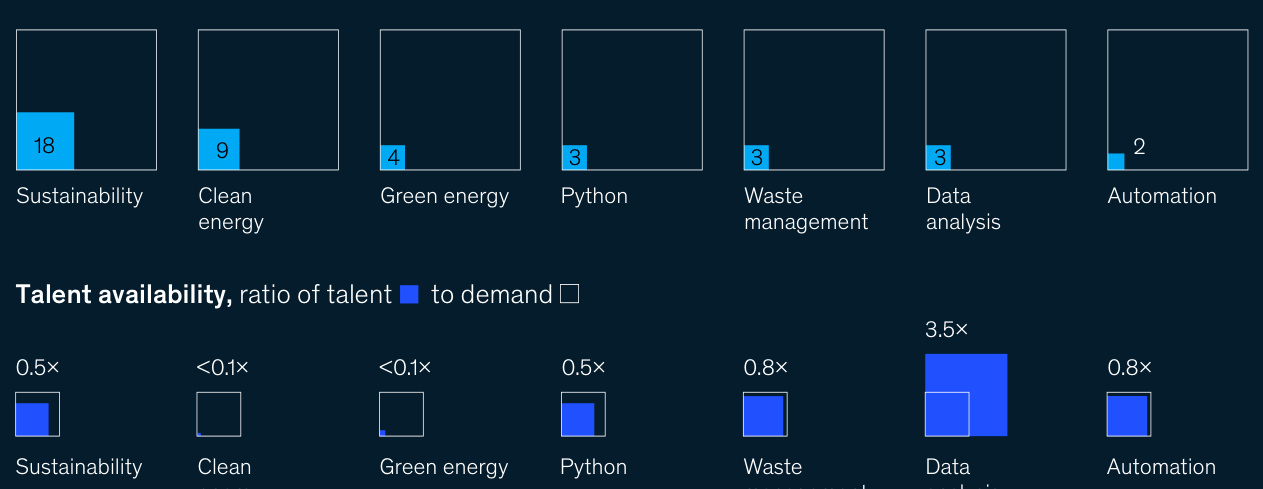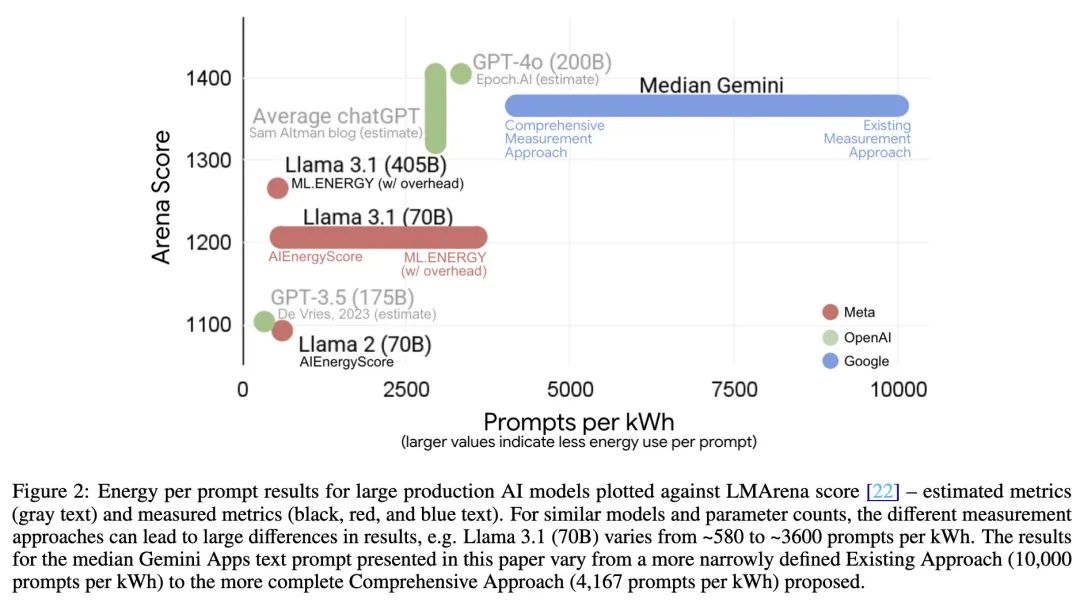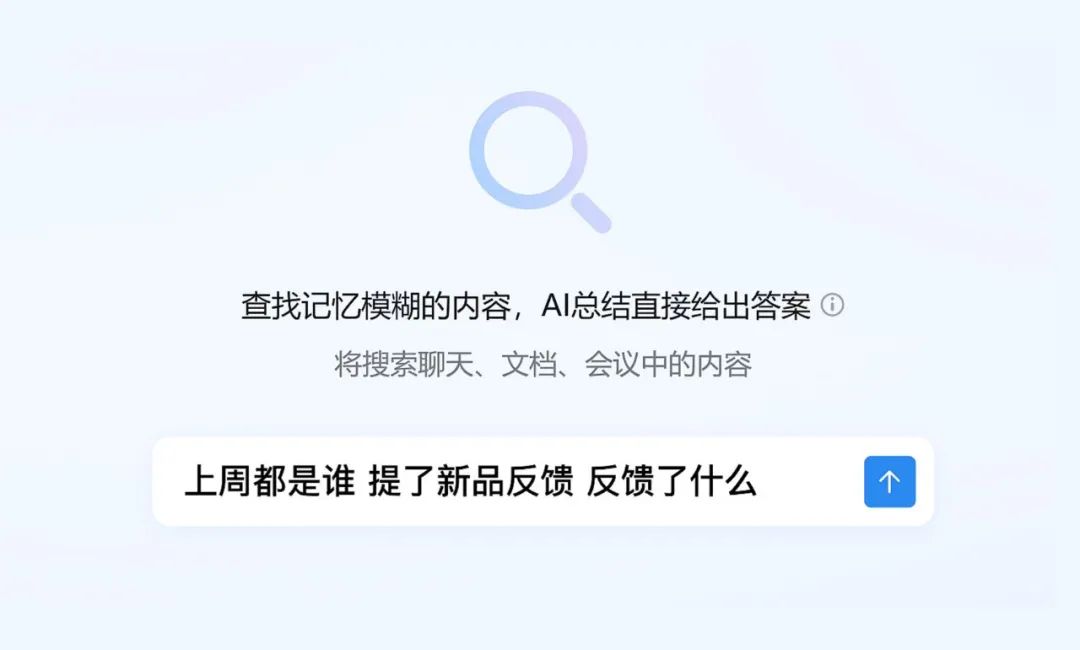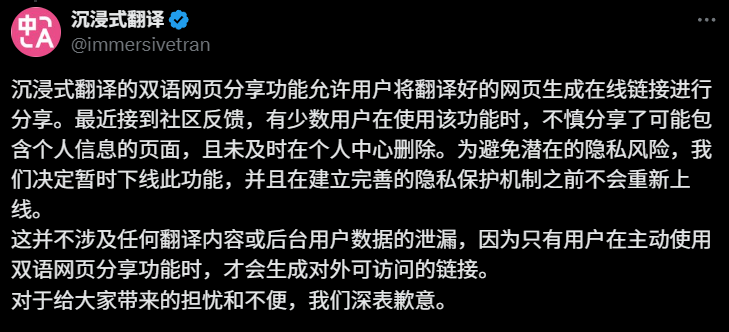July 2025 Fifth edition
Which cutting-edge technologies will be most important to businesses in 2025? Our annual technology trends report highlights the latest technology breakthroughs, talent trends, use cases and their potential impact on companies across industries.
By Lareina Yee, Michael Chui, Roger Roberts and Sven Smit
PDF原文下载:https://www.mckinsey.com/~/media/mckinsey/business%20functions/mckinsey%20digital/our%20insights/the%20top%20trends%20in%20tech%202025/mckinsey-technology-trends-outlook-2025.pdf?shouldIndex=false
catalogs
Introduction 2
The AI revolution 10
01 Autonomous AI 11
02 Artificial Intelligence 18
Computing and Connectivity Frontiers 26
03 Specialized semiconductors 27
04 Advanced connectivity technologies 34
05 Cloud and Edge Computing 41
06 Immersive Reality Technology 48
07 Digital Trust and Cybersecurity 55
08 Quantum Technology 63
State-of-the-art engineering 69
09 The Future of Robotics 70
10 Mobile Future 76
11 Bioengineering the Future 83
12. Space technology future 90
13 Energy and sustainable technological futures 97
introductory
The global technology landscape is undergoing a major shift, driven by rapid innovations in technology. These innovations are exponentially growing computing demand, attracting the attention of management teams and the public, and accelerating experimentation. These developments are taking place against a backdrop of intensifying global competition, with countries and firms competing to secure leadership positions in the production and application of these strategic technologies.
This year's McKinsey Technology Trends Outlook delves into 13 - a " baker's dozen" - cutting-edge technology trends with the potential to transform global business. Today, executives are on a mission to address increasing complexity, scale emerging solutions, and build trust in a world where the lines between digital and physical, centralized and decentralized, continue to blur. The insights in this report can help business leaders determine which cutting-edge technologies are most relevant to their organizations by showing how others are beginning to apply these trends today. These findings come from our analysis of quantitative measures of interest, innovation, equity investment, and talent for each of the 13 trends, and explore the underlying technologies, uncertainties, and related issues. (For more information on our research, see the sidebar "Research Methodology.")
This outlook highlights transformative trends that are driving innovation and addressing key challenges across industries. The impact of AI not only stands out as a powerful wave of technology, but also as an underlying amplifier for other trends, which is increasingly occurring through integration with other trends, as AI both accelerates advances within fields and unleashes new possibilities at intersections-accelerating robotics training, advancing scientific discoveries in bioengineering, optimizing energy systems, and more. The development of AI solutions on the market increasingly combines aspects of the trends we previously analyzed separately, i.e. Applied AI and Generative AI, so they are being studied together this year.
While enthusiasm for AI applications and their use cases continues to grow, realizing the full potential of AI across industries will require sustained innovation to manage computational intensity, reduce deployment costs, and drive infrastructure investment. It will also require thoughtful approaches to safety, governance and workforce adaptation, creating a wide range of opportunities for industry leaders, policymakers and entrepreneurs alike.
new highlight
In addition to the expanding reach of AI, another emerging trend we chose to highlight in this year's report is autonomous AI, which has quickly become a major focus of attention and experimentation in both the enterprise and consumer technology sectors. Autonomous AI combines the flexibility and versatility of the underlying AI model by creating "virtual coworkers" that can autonomously plan and execute multi-step workflows to act in the world. While quantitative indicators of interest and equity levels are relatively low compared to more mature trends, autonomous AI is one of the fastest-growing trends this year, indicating its potentially revolutionary possibilities.
Autonomous AI Equity Funding $1.1 Billion in 2024, Job Posting Differences in 2023-24 +985%
Artificial intelligence was also a major catalyst for another trend we highlighted this year: specialized semiconductors. While Moore's Law and semiconductor technology stack layers have long been key enablers of other technology trends, there has been a surge of innovation in the semiconductor space, as reflected in quantitative metrics such as patent counts. These innovations are responding to the growing demand for computing power, memory, and networking for AI training and reasoning, as well as the need to manage cost, heat, and power consumption. This has led to a range of new products, new competitors and new ecosystems.
Simultaneous growth in scale of technology and specialization
The growth of these vectors is driven by innovations in cloud services and advanced connectivity technologies. On the one hand, we are seeing the rapid growth of general-purpose model training infrastructures in large, power-hungry data centers, while on the other hand, we are observing accelerating innovation at the "edge" of low-power technologies embedded in cell phones, automobiles, home controls, and industrial devices. This is creating ecosystems that can provide large language models with a staggering number of parameters, as well as a range of domain-specific AI tools that can run almost anywhere. Leaders will balance centralized scale with localized control: for example, modular microgrids for clean energy or custom robots for niche manufacturing.
The need for responsible innovation
As technology becomes more powerful and personalized, trust is increasingly key to adoption. Companies are under increasing pressure to demonstrate transparency, fairness and accountability, whether in AI models, gene editing processes or immersive platforms. Ethics are no longer the right thing to do, but strategic levers in deployment that can accelerate or hinder scale-up, investment and long-term impact.
The following illustrations show how different cutting-edge technologies can work together to provide innovative solutions for the future:
Three examples illustrate the combined power of technical trends.
Maintenance of factory machines
Personalized Drug Delivery
Wind farm maintenance crew
After a year in which the macroeconomic environment and broader market weakness led to significant declines in technology equity financing for a number of our trends, the investment climate for frontier technologies stabilized and in many cases rebounded in 2024. Compared to 2023, equity investment in trends such as cloud and edge computing, bioengineering and space technology increased in 2024, while other trends such as artificial intelligence and robotics returned to higher levels in 2024 than they were two years earlier after declines in investment. The two trends with the highest levels of equity investment - future energy and sustainable technologies and future mobility - decline overall in 2023, but the former rebounds in 2024 (Chart 1).
Our 13 technology trends shaping 2025 highlight the enormous potential of emerging technologies and the need for strategic alignment in an AI-driven future.
Chart 1
In 2024, 10 of the 13 technology trends have increased equity investments.
Trend Investments, $1 billion, 2022-24
Note: Data includes private market and public market capital raisings for venture capital and corporate and strategic mergers and acquisitions (including joint ventures), private equity (including acquisitions and private investments in public equity) and public investments (including initial public offerings). Excludes corporate capital and operating expenditures. Source: PitchBook; McKinsey Analytics
McKinsey & Company
For executives, success will depend on identifying high-impact areas where these trends can be applied, investing in the necessary talent and infrastructure, and addressing external factors such as regulatory changes and ecosystem readiness. By fostering collaboration, bridging ecosystem gaps and maintaining a long-term vision, leaders can accelerate adoption and position their organizations to drive the next wave of technological change. Those who act with focus and agility will not only unlock new value, but also shape the future of their industry and of today's emerging frontier technologies.
13 technology trends
All 13 technology trends are considered in this report. To make it easier to consider related trends, we have grouped them into three broader categories: the AI revolution, computing and connectivity frontiers, and cutting-edge engineering. There is, of course, great power and potential in looking across these groupings when considering combinations of trends.
To characterize the status of each trend, we developed scores for innovation (based on patents and research publications) and interest (based on news and web searches). We also estimated the level of equity investment in the relevant technology and scored the level of adoption by organizations (Figure 2).
Chart 2
Each trend was scored based on its level of innovation, interest, equity investment and adoption.
Innovation, interest, investment and adoption by technology trend, 2024
Note: The innovation and interest scores for the 13 trends are correlated. All 13 trends exhibit high levels of innovation and interest compared to the other topics we studied and also attract significant investment.1 The innovation score combines the 0-1 patent and research scores, which are relative to the trends studied. The Patent Score is based on a measure of patent applications and the Research Score is based on a measure of research publications.2 The Interest Score combines the 0-1 News and Search Scores, which are relative to the trends studied. The news score is based on a measure of news publications and the search score is based on a measure of search engine queries.
Research methodology
To assess the development of the 13 technology trends highlighted in this report, we collected quantitative data on six specific activity metrics: search engine queries, news articles, patents, research publications, equity investments, and talent demand. For each metric or vector, we used a defined set of data sources to find occurrences of keywords associated with each trend, filtered out valid activity mentions, and indexed the number of resulting occurrences to a score range of 0-1, which is relative to the trend under study. The innovation score combines patent and research scores; the interest score combines news and search scores. (While we recognize that interest scores may be inflated by deliberate efforts to stimulate news and search activity, we believe that each score fairly reflects the extent of discussion and debate about a given trend.) Investment measures the flow of money from the capital markets to companies associated with the trend.
The data sources used for scoring include the following:
Patents. Patent application data from Google Patents, which highlights data on the number of patents granted.
Research. Research publication data from The Lens.
News. News article data from Factiva.
Search. Search engine query data from Google Trends.
Equity Investments. Venture capital and corporate and strategic mergers and acquisitions (including joint ventures) private market and public market capital-raising data, including private equity (including acquisitions and private investments in public equity) and public investments (including initial public offerings), are from PitchBook.The investment data excludes corporate capital and operating expenditures.
Talent Demand. The number of job postings is derived from McKinsey's proprietary Organizational Data Platform, which stores licensed, de-identified, publicly available professional profiles and job posting data. Data is primarily from English-speaking countries.
In addition, we have updated the selection and definition of trends from last year's report to reflect the evolution of technology trends:
An encompassing AI category replaces the following four trends: applied AI, generative AI, industrialized machine learning, and next-generation software development.
Since last year's publication, new autonomous AI and specialized semiconductor trends have been added.
Two separate trends from last year - electrification and renewable energy, and climate technologies beyond electrification - merged into one: future energy and sustainable technologies.
Data sources and keywords have been updated. For equity insights on the future of space technology and quantum technology, we build on research from McKinsey's Aerospace & Defense practice and the Quantum Technology Monitor.
Insights gleaned from McKinsey expert interviews were used to assign each trend an enterprise-wide adoption score (on a scale of 1-5), defined below:
1 - Cutting-edge innovation. The technology is still in its early stages and few organizations have invested in or applied it. It is largely unproven in the business environment.
2 - Experimentation. Organizations are testing the functionality and feasibility of the technology, usually in small-scale prototypes, and usually not focused on near-term return on investment. Few companies are scaling or have fully scaled the technology.
3-Pilot. The organization is deploying the technology in the first few business use cases through pilot projects or limited implementations to test its feasibility and effectiveness.
4 - Scaling. The organization is expanding the deployment and adoption of technology across the enterprise.
5 - Fully scalable. The organization has fully deployed and integrated the technology across the enterprise. It has become the standard and is being used at scale as companies recognize the value and benefits of the technology.
About the Author.
Lareina Yee
Director, McKinsey Global Institute, Senior Partner, San Francisco Bay Area
Michael Chui
Senior Researcher, Quantum Black Artificial Intelligence, San Francisco Bay Area
Roger Roberts
Quantum Black Partners, San Francisco Bay Area
Sven Smit
Chairman, McKinsey Global Institute, Senior Partner, Amsterdam
The authors thank the following McKinsey colleagues and alumni for their contributions to this study:
Aamer Baig
Ahsan Saeed
Alex Singla
Alex Zhang
Alexander Sukharevsky
Alizee Acket-Goemaere
Amishi Bharti
Amy Silverstein
Andrea Del Miglio
Andreas Breiter
Andreas Schlosser
Ani Kelkar
Anna Heid
Anu Madgavkar
Arjita Bhan
Bernd Heid
Bharath Aiyer
Bill Gregg
Bill Wiseman
Brooke Stokes
Bryan Richardson
Charlie Lewis
Christian Staudt
Clint Wood
Daniel Herde
Daniel Wallance
David Naney
Delphine Nain Zurkiya
Diana Tang
Egor Kiselev
Eliza Spinna
Emily Shao
Erika Stanzl
Fabian Queder
Gabriel Morgan Asaftei
Giacomo Gatto
Godart van Gendt
Hamza Khan
Henning Soller
Ichiro Otobe
Jacob Achenbach
Jakob Fleischmann
Jawad Mourabet
Jeffrey Caso
Jenny Tran
Jesse Noffsinger
Jim Adams
Jim Boehm
Jonathan Tilley
Joshua Katz
Justin Greis
Karl Grosselin
Kersten Heineke
Kevin F. Lu
Kitti Lakner
Klaus Pototzky
Klemens Hjartar
Luca Bennici
Marc Sorel
Mark Patel
Markus Wilthaner
Martin. Harrysson
Martin Kellner
Martin Wrulich
Matt Higginson
Medha Bankhwal
Mekala Krishnan
Michael Bogobowicz
Nandika Komirisetti
Naveen Sastry
Olivia White
Paolo Spranzi
Prasad Ganorkar
Ryan Brukardt
Sebastian Mayer
Sian Griffiths
Sonja Lindberg
Soumya Banerjee
Stefan Burghardt
Stephen Xu
Tapio Melgin
Tarik Alatovic
Thomas Hundertmark
Tom Brennan
Wendy Zhu
Yaman Tandon
Yvonne Ferrier
Zina Cole
Special thanks to Daniel Eisenberg, Diane Rice, Janet Michaud, Juan M. Velasco, Kanika Punwani, LaShon Malone, Mary Gayen, Michael Goesele, Nayomi Chibana, Rachel Robinson, Regina Small, Stephanie Strom, Stephen Landau, and Victor L. Cuevas bring this report to life.
AI revolution
01 Autonomous AI
Autonomous AI is a type of artificial intelligence system that can independently plan and execute complex multi-step tasks. Built on top of an underlying model, these agents can autonomously perform operations, communicate with each other and adapt to new information. Significant advances have occurred, ranging from general-purpose agent platforms to specialized agents designed for deep research.
Trends and their importance
Autonomous AI has quickly gone from a fringe concept to one of the most discussed shifts in enterprise technology. It is gaining traction as organizations explore new ways to automate workflows and delegate tasks to "virtual colleagues" rather than just talking to chatbots. Autonomous AI is unique in its ability to act in the world through digital tools, rather than simply delivering outputs. These systems are built on top of AI-based models that can autonomously plan and execute multi-step tasks.
Imagine a customer service AI agent that can answer information about products, process orders, and manage returns by connecting to a company's logistics system. Several companies have released in-depth research agents that can design their own workflows to research topics on the Web and generate reports. A growing number of companies are using software programming agents that apply their multi-step reasoning to write, deploy, and test code based on descriptions written in English or other natural languages.
Advantages of AI agents over other prior systems include the following features:
- serve unpredictable, long-tail tasks. To create software that can act autonomously, developers previously had to painstakingly program step-by-step, rule-based systems. Many of these applications had many exceptions to the rules that needed to be handled manually. In contrast, Large Language Models (LLMs) excel at correctly responding to inputs they have never encountered before, allowing LLM-based agents to handle long-tailed tasks that cannot be easily codified into predefined rules.
Use to design digital tools for people. Previously, sending or receiving data required custom code to connect to each new digital system. However, AI agents can use the same tools that people would use, such as a web browser, to "read" websites to use their LLMs and fill out forms.
Receive natural language instructions. Because LLM can handle natural language, AI agents can be managed like virtual coworkers, including giving them instructions and coaching them on how to do better using the same language they use when interacting with human coworkers.
Generate work plans that can be understood and modified. LLM-based AI agents generate work plans and, by design, they can communicate with each other. Because these agents use human-readable language, they can describe what they are doing and can be guided by feedback on their work plans.
The potential of AI agents has convinced many industries to explore recruiting agent virtual colleagues for a variety of functions and roles.
Recent developments
The development of AI agents capable of autonomous decision-making and inter-agent communication opens up exciting possibilities. However, the rapid development of autonomous AI highlights the need for robust governance frameworks to address issues of trust, responsibility, and ethics. Recent developments in autonomous AI include the following:
Developers are building AI-driven universal agent platforms. Some companies are adding agent capabilities to their existing AI offerings, while others are building them to create task-specific applications.1 These additions enable the development of agents that can interact with users through natural language and perform many different tasks. Progress has been fastest in areas where training and evaluation data are more robust, such as software coding and math.
- The growing chain of effective multi-step reasoning reflects significant advances in autonomous AI. Over the past year, new technologies have improved AI's ability to solve complex, novel tasks by breaking them down into smaller steps. Instead of relying solely on extending the base model, developers are now deploying multi-agent workflows in which a "manager" agent creates a work plan and delegates tasks to specialized sub-agents. While there is still more work to be done to ensure trust and security, this shift allows for more accurate, context-aware outputs, which is a major advancement in the way AI systems reason and operate.2
There is a growing interest in autonomous AI for business-specific solutions.AI agents are increasingly being developed for specific, high-value business problems. These agents are more specialized and tuned to their specific tasks, reducing the need for users to design complex prompts. Early attention focused on the use of autonomous AI for software development, and its capabilities have been evolving rapidly. In addition, there has been a lot of interest in AI applications that can bring measurable improvements to core business metrics, especially in sales optimization and customer support automation. As this trend grows, organizations will need to balance the use of specialized agents in their workflows with more general-purpose agents performing a variety of tasks.
The push for deep research knowledge agents is growing. Multiple providers are advancing tools that can autonomously perform multi-step exploration to obtain relevant content, perform searches, evaluate hundreds of sources, and synthesize information into comprehensive reports. These agents reflect a broader shift toward using AI not just for retrieval, but for reasoning as well, enabled by faster knowledge generation that can be scaled.3
- AI agents can "talk." Recent advances in AI include models that can communicate with each other and create their own languages.4 Neural networks can now learn tasks and describe them to other AI systems. Processing this AI-to-AI communication is less expensive than processing AI-to-human interactions. These developments in AI-to-AI communication have implications for robotics, complex problem solving, and other fields, though they also raise concerns about transparency and control.5
Growing concerns about trust, governance, and responsibility are impacting the development and deployment of autonomous AI. As AI agents take on more autonomous roles that include executing financial transactions and interacting across digital platforms, organizations are increasingly dealing with issues of accountability and legal frameworks. Recent high-profile pilot deployments have brought these risks into sharper focus, especially when AI systems act independently across jurisdictions. Designing robust guardrails and providing the right operating environment for agents is critical to ensuring reliability and accountability.
'AI agents will not only automate tasks, they will reshape the way work gets done. Organizations that learn to build teams that bring people and agent colleagues together will unlock new levels of speed, scale, and innovation.'
- Lareina Yee, Senior Partner and Director, McKinsey Global Institute, San Francisco Bay Area
Talent and labor markets
Autonomous AI
demand (economics)
The number of job postings related to autonomous AI remains small, but has grown significantly since 2021, especially for positions such as software engineers, data scientists, and data engineers. This growth is indicative of the increasing interest and investment in developing AI systems capable of autonomous decision-making and action.
Job postings, by job title, 2021-24, thousand
Skills availability
Autonomous AI development relies on a combination of technical skills, such as Python programming, machine learning, and software engineering, as well as emerging fields such as cue engineering and natural language processing. While demand for talent is high, the picture is mixed. Certain skills, such as using TensorFlow, are more readily available relative to demand, while others, such as Python expertise, are in short supply relative to demand.
Beyond usability, autonomous AI is changing the nature of work itself, shifting responsibilities from deterministic coding tasks to higher-level activities such as task planning, tool orchestration, and contextual decision-making. This evolution is changing the definition of roles, the skills that are valued, and how organizations structure their technical teams.
Talent required, percentage of skills required for job posting
Adoption developments around the globe
Adoption of fractions: 2-experiment.
Organizations are testing the functionality and feasibility of the technology, usually in small-scale prototypes, and are not usually concerned with near-term return on investment. Few companies are scaling or have fully scaled the technology.
Despite significant interest and investment in autonomous AI, the technology remains under-tested in real-world business environments. Many companies are actively testing small-scale prototype capabilities of AI agents, but full-scale adoption remains limited. Given the rapid evolution of the technology, autonomous AI is worth watching as deployment and impact could accelerate rapidly.
Real-life examples
Leading AI companies are developing advanced technologies to facilitate the implementation of autonomous AI in real-world scenarios.
Realistic examples involving AI-driven universal agent platforms include the following:
The OpenAI Operator, launching in January 2025, is an AI agent that autonomously performs a variety of web-based tasks, such as booking flights, making reservations, and ordering groceries.The Operator navigates websites, fills out forms, and handles complex interactions.6 The OpenAI Operator is a web-based agent that can perform a variety of web-based tasks autonomously, such as booking flights, making reservations, and ordering groceries.
Manus AI, launched in March 2025, is a universal agent platform. It can autonomously handle research, writing, and task management tasks, acting as a flexible digital team member.7
On June 17, 2025, Google released Gemini 2.5 Flash in Google AI Studio and Vertex AI for the Gemini API. Gemini 2.5 Flash enables developers to build production applications using browser automation features (e.g., processing visits to websites, clicking buttons, entering queries, and extracting data based on natural language prompts), supporting emerging use cases in agent workflows.8
The following is a real-world example involving multi-step reasoning:
McKinsey's Quantum Black Lab implemented an agent workflow to automate the drafting of credit memos for a bank. Initial results showed an increase in credit analyst productivity of up to 601 TP3 T. An LLM acting as a multi-agent system manager created work plans and assigned tasks to specialized data analysis, validation, and output creation sub-agents.9
Real-world examples of autonomous AI built for specific business solutions include the following:
Darktrace uses autonomous AI agents to detect and respond to complex cyber threats in real time.Darktrace's AI agents continuously monitor enterprise network traffic, identify anomalies, and determine the best course of action to mitigate potential damage.10 This approach mimics the human immune system, allowing the AI systems to immediately respond to previously unseen cyber attacks without human intervention. By automating routine monitoring and threat detection tasks, these autonomous AI systems allow human security teams to focus on strategic challenges and critical interventions.
Salesforce's Agentforce platform enables organizations to deploy autonomous AI agents across business functions to improve efficiency and scalability. These agents can autonomously handle tasks such as resolving support tickets, scheduling meetings, sending follow-up emails, and identifying leads.11
Cursor, developed by Anysphere, is one of the tools that is revolutionizing the software development industry by automating coding tasks through natural language processing. The platform allows developers to significantly accelerate the software development process by allowing them to generate code by simply describing the desired functionality in plain language.12
'Autonomous AI transforms AI from a passive tool to an active collaborator with enterprise workflows. As these systems gain autonomy and decision-making capabilities, it's equally important to invest more in figuring out how to work with AI that's seen as a colleague, not a tool. At the same time, we need strong governance, degrees of transparency and ethical safeguards to ensure that these agents operate responsibly and build lasting trust.'
- Delphine Nain Zurkiya, Senior Partner, Boston
Realistic examples involving inter-agent communication include the following:
Anthropic introduced the Model Context Protocol (MCP) as an open source framework to standardize the way AI models such as LLM integrate and share data with external tools, systems, and data sources. Google, Microsoft, Open AI, and many other companies have announced that they will adopt MCP.
Google introduced the Agent2Agent (A2A) protocol, an open standard designed to facilitate secure collaboration between cross-vendor AI agents. Supported by more than 50 partners, A2A supports use cases such as candidate sourcing and supply chain orchestration, complementing efforts like MCP to unlock a scalable multi-agent ecosystem.13
potential technology
The technologies that drive AI include the following:
Machine Learning (ML). These models make predictions after being trained with data rather than following programming rules.
- Natural Language Processing. This type of ML analyzes and generates language-based data, such as text and speech.
Application Layer. Typically, this is the interface that end users interact with - such as chat.
Integration/Tools Layer. Located between the application layer and the base model, this layer integrates with other systems to retrieve information, filter responses, save inputs and outputs, distribute work, and enable new functionality. Examples include the large language programming framework LangChain and vector databases such as Pinecone and Weaviate.
- Base models. These are deep learning models trained on large amounts of unstructured, unlabeled data that can perform a wide range of tasks out-of-the-box or can be fine-tuned to fit specific tasks.
Reasoning models. These are base models specifically trained to perform multi-step reasoning tasks, such as solving problems involving logic and making inferences beyond pattern recognition.
Observability tools. These are tools (e.g. LangSmith) that enable observability (insight into behavior, performance, and decision-making processes). They monitor and analyze AI models throughout their lifecycle to ensure reliability, transparency, and accountability.
Programming frameworks. Such frameworks are comprehensive software toolkits designed to facilitate the development and implementation of AI applications, such as Autogen and CrewAI.
Key uncertainties
The main uncertainties affecting autonomous AI include the following:
- Failure modes of autonomous AI, such as making poor decisions or taking unintended actions, can pose operational risks. There are other risks associated with the quality of data used to train these agents, biases in decision models, adversarial attacks, and the continued need for human oversight to manage increasingly autonomous systems. - The level of autonomy that agents can achieve remains uncertain and is the subject of ongoing research and debate in AI.
Big questions for the future
There are a number of issues that companies and leaders may want to consider as they move forward with autonomous AI:
- Will the large-scale workforce impact of autonomous AI include a combination of human and digital labor? What trust and security tools and techniques will be needed to mitigate risks as companies adopt autonomous AI?
Is autonomous AI more likely to boost expert talent by automating routine tasks, or will it replace a large workforce built on structure and repetition?
To what extent should autonomous AI be allowed to operate independently? How do we strike a good balance with AI autonomy and human oversight?
How can companies get ahead of their competitors and capture the value associated with autonomous AI at scale, both in terms of revenue and cost benefits?
02 Artificial Intelligence
Artificial intelligence refers to computer systems designed to perform tasks that would normally require human intelligence. These systems use algorithms, data, and computational power to recognize patterns, make decisions, and learn from experience.
Trends and their importance
Artificial intelligence is no longer just a technological curiosity. Today, it's driving tangible change across industries and everyday life. From supporting natural conversations and automating complex analytics to controlling physical systems like robots and drones, AI's impact is broad and far-reaching. The most effective solutions often blend multiple forms of AI: generative models for language, analytics engines for data-driven insights, and agentic AI that is increasingly able to make decisions and act autonomously (introduced in a previous section of this report). This convergence is quietly changing the way organizations operate and the way individuals interact with technology.
78% of organizations surveyed in McKinsey's State of AI Report are using AI in at least one business function, and 92% of executives plan to invest more in the next three years, as we highlighted in Super Agents at Work.1 Nonetheless, it's still an early trend, with only 1% of leaders indicating that their firms are at AI deployment fully mature in terms of AI deployment.2 The rapid development of foundational AI capabilities over the past year has made the long-term potential of AI for the enterprise even more promising. The cost of deploying powerful models is dropping dramatically, and a new generation of smaller, more specialized models is enabling more organizations and a wider range of devices to access AI.
Multimodal AI capable of processing and generating text, images, video and audio has opened up new creative and scientific frontiers, improving the quality and versatility of AI-driven output. As a result, businesses and consumers are now more likely to integrate AI into their workflows and daily routines. The impact on workflows is particularly evident in software development. The rise of natural language-based tools has democratized programming to the point where professionals and hobbyists alike can build and prototype software faster than ever before. However, this acceleration also brings new challenges, such as managing technical debt and ensuring code quality as development speeds up.
The use of generative AI, which became commercially available less than three years ago, has evolved very rapidly: most companies that report using AI also say they use generative AI on a regular basis.However, as mentioned above, organizations still have a long way to go before they realize the full potential of generative AI. The large gap between potential and progress can be explained by the time it takes for organizations to adapt, develop complementary innovations, and retrain employees. Thus, the true economic benefits of generative AI may only become apparent after substantial organizational change and restructuring has taken place.
As we look to the year ahead, several key questions emerge: will lower model inference costs and the explosion of smaller, specialized models continue to reshape access to and the benefits of AI? Which enterprise strategies will unlock the most value as organizations race to move from experimentation to full adoption? As innovation accelerates, how can leaders ensure that responsible practices - around ethics, transparency and governance - keep pace with the rapid integration of AI into business and society?
AI revolution
artificial intelligence (AI)
Trends in ratings
From 2023 to 2024, there is a surge in innovation and interest in AI as the introduction of generative AI ignites interest in all things AI. AI leads technology trends in patent activity, Google searches, and research publications, reflecting its rapid adoption across industries and disciplines. In the first quarter of 2025, AI companies raised $52 billion, including a $40 billion investment in OpenAI led by SoftBank, which marked the largest venture capital (VC) funding deal ever.
Note: For each vector, we used a defined set of data sources to find occurrences of keywords related to each of the 13 trends, filtered out valid mentions of the activity, and indexed the resulting occurrences to a rating range of 0-1, which is relative to the trend under study.1Swagath Bandhakavi, "AI Companies to Raise at 2025 Raise at Least $52 Billion Globally in Q1 2025," Tech Monitor, April 17, 2025; "New Funding to Build AGI," OpenAI, March 31, 2025; Hayden Field and Kate Rooney, "OpenAI completes $40 billion funding round, largest private tech deal on record," CNBC, April 1, 2025
Recent developments
Innovation in AI 2025 is accelerating around augmented modeling capabilities, efficiencies, and real-world applications, driven by competition between tech giants and startups, while the field increasingly faces challenges in responsible deployment, regulation, and expanding commercialization.
Recent developments involving AI include increased competition and declining inference costs, an explosion of smaller models, advances in multimodal AI and multistep reasoning capabilities, accelerated software development, concerns around responsible AI, and increased global investment:
The proliferation of base models has increased competition and lowered costs. Many competitors offered free access and price reductions for high-quality text output, and the emergence of startups further fueled innovation. The number of high-quality open-source models has also increased.
The field of Artificial Intelligence has witnessed an "explosion of smaller models" as distillation and quantization techniques have enabled the creation of highly capable, domain-specific AI models derived from larger "parent" models. These smaller models provide high-quality outputs while requiring less computational power, thereby dramatically reducing costs and energy consumption. Previously, companies typically used larger models, many of which could handle more than a trillion parameters, but many now recognize that smaller models that handle ten billion parameters or less are just as effective. As a result, AI is now being integrated into everything from smartphones and home appliances to trucks and industrial equipment.
Companies are redoubling their efforts to develop multimodal generative AI models to integrate and process multiple types of data inputs and generate outputs such as text, images, video and audio. These multimodal models enhance natural language interactions with more effective prompts and better output. Multimodal outputs are also improving, including video and more complex scientific outputs such as recognizing subtle correlations between protein folding and drug potency.Gartner predicts that by 2027, 40% of generative AI solutions will be multimodal, compared to only 1% in 2023.3
Artificial intelligence is getting better at complex multi-step reasoning, a major shift in its capabilities. Recent advances have allowed the underlying models to plan strategically, adapt to variability, and promote knowledge between tasks, increasing their efficiency and reliability. Optimized training algorithms, deep research tools, and other techniques demonstrate how AI can reason more quickly and apply insights to new challenges,4 including software engineering.
The industry is moving from principles to action on responsible AI. As the adoption of generative AI accelerates, concerns about plagiarism, accountability, data pollution, bias, and fairness remain. Using copyrighted material to train generative AI models has sparked debates about intellectual property and fair use. Lack of transparency about how outputs, especially non-mathematical outputs, are determined has increased interest in "explainable AI" that can shed light on its reasoning. To address these challenges, organizations are implementing AI governance platforms and seeking third-party trust and risk assessments.
Global investment is expanding, but its distribution varies by region. Sovereign AI, which has the potential to foster local innovation, economic growth, and national interests, is gaining significant attention globally. Countries such as France, Italy, Spain, and the United Kingdom are developing domestic AI infrastructure by fostering ecosystems of technology companies, as well as cloud and telecom providers.5 In Vietnam, NVIDIA is partnering with the government to establish a new AI research center, while Japan, Singapore, and Thailand are encouraging the development of localized AI models aligned with national priorities, such as healthcare and natural disaster management.6 In the Middle East, countries including the United Arab Emirates are rapidly positioning themselves through large infrastructure projects and cross-border collaborations, such as Emirates NBD Bank's recent partnership with BlackRock.7 In contrast, regions such as Africa are lagging behind in adoption due to a lack of digitization, high costs, and other challenges.8
VC investment in AI has grown significantly, driven primarily by generative AI startups. This influx of capital is driving innovation across the AI stack, from hardware pioneers such as SambaNova Systems, which develops advanced chips, to application companies such as Writer, which creates customized solutions for a wide range of industries.Enterprise AI investment has reached unprecedented levels, with tech giants and leading AI companies collectively investing tens of billions of dollars annually in infrastructure, models, and deployments. Google's parent company Alphabet, Amazon, Meta, and Microsoft are expected to spend between $70 billion and more than $100 billion on AI-related capital expenditures in 2025, driven by data center expansions and custom silicon development.9 Such huge expenditures, which far outstrip earlier investments in the cloud, underscore the strategic importance of AI and are driving rapid innovation.
'The pace of AI innovation is accelerating, with breakthroughs in generative and autonomous systems rapidly expanding the possibilities across industries. Today, the real differentiator is not just technical capability; it is the ability to deeply embed AI into workflows to deliver measurable business impact by reshaping operating models, talent and governance. Organizations that move from experimentation to mass adoption while building strong safeguards for trust and accountability will be most likely to capture the transformative potential of AI.'
- Alex Singla, Senior Partner and Co-Head of Quantum Black, Chicago
artificial intelligence (AI)
demand (economics)
AI talent demand continues to evolve as organizations transition from early experiments to broader deployments. Despite a sizable pullback in 2023, 2024 brings a new hiring boom - particularly for data scientists and engineers - as companies look to embed AI more deeply into core workflows. Demand for software roles has stabilized, while growth in product and solution-oriented roles suggests a growing emphasis on driving business integration and user impact.
While 46% leaders cite skills gaps in the workforce as a major barrier to AI adoption, and more than 20% employees report little to no training, addressing today's need for skill enhancement is only part of the problem. As AI agents are increasingly integrated into enterprise workflows, the talent landscape will continue to evolve toward the ability to support human-machine collaboration. Over time, this symbiotic relationship between workers and AI will become less ad hoc and more foundational, gradually reshaping how teams function, how decisions are made, and how value is created within organizations.1
Job postings, by job title, 2021-24, thousand
Skills availability
The AI talent pipeline is under pressure. Core skills such as machine learning, Python and data science are in high demand, but supply still lags behind the latter two. Cloud infrastructure expertise is particularly scarce, especially for platforms like Amazon Web Services (AWS). Even though some programming and math-related competencies are more readily available, the gap in foundational AI skills is likely to slow momentum unless it is addressed through targeted skills enhancement and development.
Talent required, percentage of skills required for job posting
Talent availability, ratio of talent to demand
| <0.1x AmazonWeb Services | 0.5x Python | 0.3x DevOps | 0.3x Kubernetes | 1.3x Linux | 0.7x Databases | 0.1x Scripting |
Global adoption development
Adoption of scores: 4-being extended.
Organizations are scaling technology deployment and adoption across the enterprise.
Many global organizations have already adopted cloud technology, with the United States and Western Europe leading the way in adoption. However, as the demand for computing continues to grow, fully scaling the technology will be a challenge. Meanwhile, bottlenecks in power, hardware supply chains and networks remain. Certain regions of the globe, such as Africa, have not yet received much attention for edge computing and are therefore lagging behind.
Real-life examples
The evolution of cloud and edge computing is enabling AI to run in cloud stacks, addressing compute and power constraints, and giving rise to specialized cloud providers and sovereign cloud extensions.
Real-world examples involving AI disrupting the cloud stack include the following:
Meta has developed a dedicated data center network that uses GPU clusters to support large-scale distributed AI training.Meta's AI capacity uses Converged Ethernet version 2 (RoCEv2) as an inter-node communication transport. The company's network supports a wide range of reliable, real-world AI training tasks-such as ranking, content recommendation, and natural language processing-running on its GPU clusters.6
The Stargate program, announced in January 2025, invests $50 billion over the next four years to build new AI infrastructure for OpenAI. Funders include MGX, OpenAI, Oracle, and SoftBank.7
Realistic examples involving companies overcoming computational constraints include the following:
Hybrid cooling strategies are becoming increasingly important as computing demands grow. Data centers now combine air cooling for low-intensity applications with liquid cooling for high-density racks. Microsoft has introduced a water-efficient, closed-loop, chip-scale cooling system that eliminates water evaporation and provides precise temperature control.8 Technologies such as HyperCool use waterless, two-phase, direct-to-chip cooling for AI GPUs up to 2,800 watts, using between 10 and 201 TP3T less energy compared to traditional methods.9
- As more data centers are built, the increased power needed to operate them is becoming an issue in U.S. markets that have traditionally had clusters of data centers, such as northern Virginia and Santa Clara, California. Many utilities are unable to build transmission infrastructure fast enough and may ultimately not be able to generate enough power.10 Data centers dedicated to AI models are being built in more remote parts of the United States, where power is still plentiful and the grid is under less stress, such as in Indiana and Iowa.11 Similarly, Southeast Asian countries, such as Thailand and Indonesia, and Nordic countries, such as Finland, which are home to abundant renewable energy, are becoming key hubs for AI infrastructure.12
As AI models are increasingly embedded in everyday applications, the industry is shifting from sheer scale to efficiency. Against this backdrop, DeepSeek's R1 model stands out as a leading example.Using techniques such as Multiple Latent Attention (MLA) and FP8 precision quantization, the R1 model significantly reduces memory and computation requirements, enabling high-performance inference even on consumer-grade hardware. This approach reflects a broader trend in cloud and edge computing: optimizing AI workloads for responsiveness and resource efficiency, bringing intelligence closer to where data is generated and decisions are made.13
Companies are distributing workloads across more and more machines. For example, AWS Trainium trains the Llama 2-7B model by splitting the model across 128 servers, distributing tasks between chips, and breaking down long sequences between staff. This significantly reduces training time and costs compared to a single machine. Similarly, companies are moving to areas with better power supply or using edge computing to process data closer to the data source.14
Here's a real-life example of the rise of the professional gamer:
CoreWeave, backed by Nvidia, has emerged as a key player in the cloud computing space by offering specialized GPU-accelerated cloud services tailored for AI and machine learning workloads. It serves niche markets such as AI model training and inference, providing high-performance GPUs, such as the Nvidia H100, to startups and research organizations.14 The company is growing rapidly, with revenues surging to $1.9 billion in 2024, a year-over-year increase of 7,37%, and an initial public offering (IPO) in March 2025.15
Realistic examples involving the growing demand for sovereign cloud include the following:
In 2024, Oracle expanded its Sovereign Cloud to cover the European Union. This allows European companies to process data locally using Oracle's cloud infrastructure.16
Delos Cloud, founded by SAP, is partnering with Arvato Systems and Microsoft to deliver a sovereign cloud solution tailored to the German public sector. The platform is designed to enable government agencies to securely distribute sensitive workloads across multiple data centers within Germany.17
potential technology
The technologies driving cloud and edge computing include the following:
- Virtualization. Virtualization enables the creation of virtual instances of servers, storage, and network resources, allowing for resource sharing and isolation.
- computing and serverless computing. This technology provides on-demand computing resources, including a serverless model managed by a cloud provider, which allows developers to focus on code.
Containers and Kubernetes. containers encapsulate applications and their dependencies for consistent deployment across environments, while Kubernetes manages container orchestration at scale.
APIs and microservices.APIs facilitate communication between cloud applications and services, while microservices break down applications into smaller, more independent components for increased scalability and flexibility.
Cloud storage. This technology includes scalable and easily accessible storage solutions, such as object storage and block storage, which help manage data in the cloud.
Internet of Things (IoT) or the device edge.IoT devices such as sensors and video cameras collect and process data. These devices typically have basic computing and storage capabilities.
Local or "near-action" edge. These are computing and storage resources deployed within the premises where the data are generated or in remote or mobile locations.
Carrier, Network and Mobile Edge Computing (MEC). These are private or public compute and storage resources deployed within the edge of a mobile or converged service provider's network, typically one network hop away from the enterprise premises.
Metro Edge. Using this technology, data centers with smaller footprints (typically around three megawatts) located in large cities complement the public cloud, providing near-local compute power and storage to deliver lower latency and higher availability.
Fiber Optics. Physical glass fibers provide the most reliable high-throughput, low-latency connections.
Key uncertainties
Key uncertainties affecting cloud and edge computing include the following:
As chip technology advances, balancing faster performance with lower energy consumption in hardware and software remains a key challenge. Regulatory scrutiny and data privacy concerns are driving increased attention to cloud governance and data sovereignty. The environmental impact and sustainability of accelerated data center expansion, power purchases, water usage and e-waste may lead to additional regulation.
- Security in cloud and edge computing will remain a critical issue in 2025. Organizations face growing security risks due to limited visibility into multi-cloud environments and insufficient investment in protection.
Big questions for the future
Companies and leaders can consider the following questions when continuing to use cloud and edge computing:
- How can cloud providers effectively reduce their energy consumption and carbon footprint? How can companies ensure data sovereignty and compliance with evolving regulations in a multi-cloud environment?
- Will there be regionally dominant cloud providers? What will define competitive advantage in the cloud over the next five years - scale, architecture or ecosystem control?
- As cost curves, tariffs and regulatory pressures evolve, how should organizations dynamically optimize their workloads across cloud, edge and local platforms?
06 Immersive Reality Technology
Immersive reality technologies include augmented reality (AR) and virtual reality (VR), including AR smart glasses, advanced haptic feedback, and AI-driven enhancements to improve rendering, tracking, and processing.
Trends and their importance
Immersive reality technologies - including augmented reality (AR), which projects images into real environments, and virtual reality (VR), which enables interaction in fully virtual environments through spatial computing - have the potential to transform the experience in many industries. These technologies continue to evolve, with advancements such as lighter, more affordable wearables, improved haptics and AI integration. While gaming and entertainment remain the most widely adopted and visibly innovative areas, these technologies are also being used in other areas for marketing, prototyping, and simulating high-risk scenarios to improve training and safety. By providing a safe, controlled environment, AR and VR allow users to practice skills and experiment without the risks of the real world. In healthcare, immersive technologies support medical training and patient care.1 In 2024, the AR/VR market grew steadily, with headset shipments growing by 10%, although forecasts indicate that growth may slow in 2025.1
'Immersive reality is rapidly moving beyond its gaming and entertainment roots to become a transformative force across industries. As the technology matures, organizations that consciously integrate it into their operations will unleash new dimensions of productivity, creativity and human connection. The next wave of innovation will be defined not only by technological advances, but also by how seamlessly immersive experiences fit into the fabric of everyday business and life.'
- David Naney, Senior Specialist, Southern California
Recent developments
Recent developments involving immersive reality technology include the following:
Historically, AR and VR headsets have underperformed expectations. This is due to high costs, limited consumer adoption, and technology constraints - although there is evidence of reinvestment, such as Meta's AI glasses and Google's Android XR glasses.2
Advances in haptic technology are blurring the lines between reality and simulation. The integration of haptic technology and advanced sensory feedback is creating more immersive and realistic virtual environments. Ultra-low-power haptic actuators and wearable gloves and suits provide precise tactile feedback, simulating sensations such as rain or texture. Chemical sensors and wireless dispensers replicate flavors. This multi-sensory approach increases user engagement in a variety of applications.
- AI integration is revolutionizing AR and VR technology, improving rendering, tracking, and processing capabilities, especially in gaming and training simulations.AI algorithms generate hyper-realistic environments and characters in games that dynamically respond to user interactions, creating a more immersive experience. AI techniques, including deep learning models, improve the fidelity of 3D visualizations by training on large datasets of real-world textures and lighting conditions.3
Talent and labor markets
immersive reality technology
demand (economics)
Demand for mechanical engineering jobs has remained relatively stable compared to software jobs, reflecting the continued need for hardware expertise in the fabrication and prototyping of AR and VR devices.The overall decline in talent demand for most job titles in 2024 suggests that the job market is recalibrating as the field's use cases and support structures evolve.
Job postings, by job title, 2021-24, thousand
Skills availability
The immersive reality space faces a shortage of VR, AR and AI skills, driven by a growing demand for adaptive simulation and AI-driven content creation. Programming skills, such as C++, are more readily available, while 3D modeling expertise remains plentiful.
Talent required, percentage of skills required for job posting
Talent availability, ratio of talent to demand
Global adoption development
Adoption of fractions: 2-experiment.
Organizations are testing the functionality and feasibility of the technology, usually in small-scale prototypes, and are not usually concerned with near-term return on investment. Few companies are scaling or have fully scaled the technology.
Adoption of immersive reality technologies varies widely in terms of geography and use cases. While smart glasses have gained meaningful traction, headset adoption has been slower than expected. Momentum is building in sectors such as healthcare and consumer goods, yet widespread adoption remains limited by usability issues, high costs, and regional differences in infrastructure and innovation.
Real-life examples
Realistic examples involving the use of wearable devices include the following:
Help bridge the gap between physical presence and digital interaction. Despite the company's subsequent decision to discontinue production of the initial model, Apple's Vision Pro headset, which first shipped in early 2024, marks a milestone in the immersive reality technology market. One of its features is "Persona," which uses AI and AR to scan a user's face and create realistic digital avatars during FaceTime calls, allowing users to communicate more naturally in a virtual environment.4
Widening the field of view of smart glasses. Widening the field of view is considered an important factor in the growth of AR, and the fifth generation of Snap's Spectacles, which was released in September 2024, makes progress in this area. Aimed at AR developers, it features a more immersive display, more intense colors, and a wider 46° diagonal field of view, as well as longer battery life and enhanced processing power.5 Despite these improvements, the category still faces challenges, such as a relatively limited field of view and heavy device weight.
Making VR more immersive and accessible for casual users and enterprise applications.The grand vision for VR headsets has been limited by technical challenges. Products like the Meta Quest 3, a standalone headset launching in 2023, mark another step in the evolution of immersive hardware. In addition to not requiring a constant connection to an external PC or console, it features improved graphics, processing power, and rendering.6
Dr. Joaquin Sanchez-Sotelo performed the first mixed reality navigated shoulder replacement surgery at the Mayo Clinic in 2024. This innovative surgical method uses specially designed tools and goggles to create a highly accurate hologram of the joint, allowing for increased precision when placing implants.7
Reduce the time it takes to build a prototype. Physical prototypes typically take 45 days, but New Balance uses VR to reduce the process to just seven days or less. This VR-based approach allows decision makers to view the shoe design from all angles in a virtual environment, similar to handling a physical sample. Using VR in this regard makes it easier to communicate design intent and allows for more informed decision-making.8
Realistic examples involving how haptic and other sensory technologies can enhance the virtual experience include the following:
A more immersive and engaging gaming experience.Virtuix has introduced the Omni One, its consumer-oriented multi-directional VR treadmill that allows users to move in any direction within a virtual space. This 360° capability increases presence in the VR environment.9
Bringing haptics to VR. haptic gloves are designed to help wearers naturally and intuitively interact with virtual objects. contact CI's Maestro EP, the lightweight, wireless model the company is showcasing at AWE 2024, represents an advancement in this space. Since 2020, the U.S. Air Force has used Contact CI's haptic technology for VR training programs, a practical application of these gloves in a professional setting.10
More intense flavors in virtual taste simulations. Addressing and meeting consumer demand for multi-sensory digital ecosystems is a major concern in the field of immersive reality technology. One recent innovation simulates the workings of taste buds. Developed by researchers at Ohio State University, e-Taste technology uses chemical sensors and wireless microfluidic actuators to replicate sweet, sour, salty, bitter and umami flavors by controlling the release of ions and flavor compounds. Human trials achieved 70% accuracy in distinguishing flavor intensity.11
Realistic examples involving how AI is changing immersive reality applications include the following:
Blockade Labs developed Skybox AI, an advanced AI-driven tool for creating immersive 360° panoramic environments. Users can generate detailed 8K resolution skyboxes with simple text prompts and can remix existing environments, edit elements, and even convert 2D skyboxes into 3D models for a variety of applications. This technology can be applied to gaming, VR, simulation, education, and more.12
Using AI to create game NPCs reaches a new level.2023 Epic Games introduced a new AI-driven feature for its versatile 3D computer graphics game engine, the Unreal Engine (UE). Called the Programmatic Content Generation Framework,13 it uses AI algorithms to automatically generate game assets such as landscapes, 3D objects, buildings, and even entire worlds. As a follow-up to the AI enhancements, the company introduced MetaHumans to Fortnite's Unreal Editor, allowing creators to design and animate high-fidelity, digitized "human" non-player characters (NPCs) for their Fortnite islands.14 UE's Behavior Tree assets can be be used on its own to implement intelligent AI behaviors for NPCs. 14
potential technology
The technologies that drive immersive reality include the following:
- Augmented Reality.AR achieves partial immersion by adding information to the real-world environment.
Virtual Reality.VR immerses the user in a completely virtual environment through spatial computing, allowing interaction in a completely virtual environment.
Mixed Reality. Mixed reality achieves a level of immersion between AR and VR, adding virtual elements to the real world so that users can interact with both.
Spatial Computing. This type of computation uses the 3D physical space perceived around the user as a canvas for the user interface.
Wearable and external sensors. These sensors, embedded in or mounted around the user in a handheld or wearable device, detect objects and bodies for representation in a virtual environment.
Haptics. These feedback devices typically convey sensations to the user in the form of vibrations.
Location-based Augmented Reality. The software integrates the user's real-time physical location and surroundings into AR to overlay the physical surroundings in a virtual environment.
Machine Learning. This term refers to models that make predictions after being trained with data, rather than following programming rules.
Artificial Intelligence. ai refers to the ability of a machine to perform cognitive functions normally associated with the human mind, such as perceiving, reasoning, learning, interacting with the environment, and problem solving.
Key uncertainties
The main uncertainties affecting immersive reality technology include the following:
Data availability and data privacy. Immersive technologies like virtual and augmented reality collect large amounts of personal data such as body movements, eye tracking, and how users interact with their surroundings. This raises serious privacy concerns. Some advanced AI systems can even interpret unconscious behaviors, including eye movements, to guess what the user is thinking or feeling-often without the user being aware of it. There is a real risk that this information could be misused or exposed in a data breach, so protecting user privacy is critical.
- Amplifying prejudice. If implemented incorrectly, immersive technologies can reinforce existing social biases. For example, candidates with reliable internet and access to updated equipment or dedicated VR workspaces may benefit more from virtual hiring processes, educational programs, or access to public services.
Physical security. Augmented and virtual reality systems often limit the user's view of the real world. This creates a safety hazard when the use is not in a tightly controlled environment.
Multiple device types. There is a wide variety of immersive technology devices, ranging from standalone AR and VR platforms to peripheral AR accessories for cell phones. This diversity makes it unclear which devices are best suited for specific tasks. As new products continue to emerge, users face uncertainty in choosing the right tool for their needs.
Hardware Development. Hardware advances have been made at varying rates in areas such as weight, thermal management, battery life, field of view, and motion sickness reduction. Some areas are evolving faster than others due to technical challenges or market demand. While steady progress can be expected, the timeline for making substantial progress in all areas simultaneously remains uncertain.
Big questions for the future
There are several issues that companies and leaders may want to consider as they move forward with immersive reality technology:
- How will the speed of hardware breakthroughs - across cost, comfort and performance - shape the evolution of immersive reality from niche novelty to universal platform?
- What is the tipping point for immersive reality to transition from pilot projects to scale deployments in specialized, high-value areas such as energy infrastructure, advanced manufacturing or high-end media?
- How will immersive reality shift and adapt as more organizations embrace a return to the office and less remote work?
- What regulatory frameworks are needed to ensure the safe, secure and ethical use of virtual reality technologies, including content vetting, data privacy and cybersecurity?
- How will the widespread adoption of virtual reality technology affect society and human behavior?
07 Digital Trust and Cybersecurity
Digital trust and cybersecurity covers technologies and practices designed to ensure secure, transparent and trustworthy digital interactions. This includes authentication, data protection, encryption, threat detection and blockchain-based trust systems.
Trends and their importance
Digital trust and cybersecurity trends include cybersecurity, artificial intelligence trust and blockchain technology. These technologies build, extend and maintain stakeholder trust. They help organizations mitigate technology and data risks, innovate and protect assets, which contribute to enhanced organizational performance and stronger customer relationships.
Cybersecurity and artificial intelligence provide advanced defense mechanisms against increasingly sophisticated cyber threats. They can enhance threat detection, incident response and overall digital resilience for any organization.
AI trust systems provide interpretability, fairness, robustness, and security, which can build user and stakeholder confidence. The importance of trust cannot be overemphasized as AI is increasingly integrated into everyday life and critical decision-making processes.
Blockchain-based tokenization systems, which are essentially built for transparency, security, and accessibility, may lead to innovative solutions for areas such as finance and healthcare.
Together, these technologies work to build digital trust and protect data integrity. Fully reaping the benefits of digital trust and cybersecurity requires top-down leadership and intentional change in multiple areas of activity, from strategy and technology to enterprise capabilities.
'The core foundations of cybersecurity - asset management, vulnerability management and identity management - remain critical in a world where generative AI continues to unlock more and more value. Creating systems and processes to deliver secure customer and user experiences in the era of generative AI requires both maintaining foundational security capabilities and investing in leading-edge technologies to keep pace with change.'
- Charlie Lewis, Partner, Connecticut
Recent developments
Recent developments in the area involving digital trust and cybersecurity include the following:
Rapid advances in AI technology and disruptions across industries and everyday life highlight the urgent need to build trust in AI across the value chain. Trust in AI companies has declined, from 611 TP3T in 2019 to 531 TP3T today.1 Failure to proactively implement responsible and safe AI practices could have significant consequences for companies and society. Cumulative stock market returns for trusted brands are 245 percentage points higher than untrusted brands from 2017 to 2023,2 illustrating digital and operational resilience and how trust pays off.
Attackers are increasingly using generative AI and machine learning to target organizations, and doing so more effectively. At the same time, organizations themselves are adopting these technologies to enhance threat detection and response capabilities. These tools enable systems to quickly analyze large data sets, identify patterns and detect anomalies to improve threat detection and prevention.
The exploitation of vulnerabilities in third-party software and functionality highlights the broader impact of systemic risk. As the industry becomes increasingly dependent on third-party software and functionality, risks are concentrated in various business processes, increasing the need to design and implement software bills of materials to improve transparency and manage vulnerabilities.
Concerns about regulatory oversight, transparency and security in the digital sphere have increased. Governments across the globe have taken significant steps to develop more comprehensive and stringent regulations, as concerns about digital trust have highlighted the need for clear governance frameworks.
Geopolitical risks have intensified, posing significant threats to digital trust and cybersecurity. In this uncertain environment, where States are increasingly utilizing technology for strategic purposes, concerns about critical infrastructure and data security are growing. Critical infrastructure, such as satellites and submarine cables, have been targeted, which could disrupt global communications, commerce and security. Organizations can take a proactive and adaptive approach to cybersecurity by incorporating geopolitical factors into risk assessment and mitigation strategies.
Tokenization is increasing in industries such as finance as institutions seek to expand their product offerings. Blockchain technology, which provides the ability for interoperable, tamper-proof ledgers, is enabling applications such as tokenized assets.
'Trust is no longer a soft issue; it is a business-critical asset. In a world of AI-generated content, cross-border data flows and rising cyber risk, digital trust is a license to operate. Companies that build trust by design will be the ones that customers choose - and the ones that have the support of social stakeholders.'
- Roger Roberts, Partner, San Francisco Bay Area
Talent and labor markets
Digital trust and cybersecurity
demand (economics)
Software jobs related to digital trust and cybersecurity remain critical, with demand for software engineering and software development relatively stable, albeit down slightly from 2023. Security analyst jobs, while down significantly from their 2022 peak - as are most job titles in this trend - remain ahead of overall job postings, reflecting continued demand for threat monitoring and compliance expertise.
Job postings, by job title, 2021-24, thousand
Skills availability
Popular skills such as incident response, threat intelligence and DevOps (software development and IT operations) are facing severe shortages, reflecting the industry's urgent need for threat mitigation and automation expertise. Artificial intelligence is becoming increasingly critical as companies integrate AI-powered security tools for threat detection and response, but talent remains scarce. Conversely, risk management shows a slight surplus of talent, indicating alignment with current training pipelines. Regulatory uncertainty and market volatility have led to a volatile talent market for blockchain and distributed ledger skills.
Talent required, percentage of skills required for job posting
Talent availability, ratio of talent to demand
| 1.2x 0.3x | 0.2x | 0.3x | 0.7x | 0.1x | 2.6x | |
| Risk management | Incident response | Artificial intelligence | DevOps | Databases | Threat intelligence | Blockchain |
Global adoption development
Adoption of scores: 4-being extended.
Organizations are scaling the deployment and adoption of these technologies across the enterprise.
Even as cybersecurity expands across the board throughout an organization, technological advances mean it must continue to evolve. For example, AI trust technologies are still in early pilot stages, despite the rapid rollout of generative AI. A few organizations are developing custom cybersecurity solutions, but most rely on providers to scale. The European Union has jumped ahead of the curve to strengthen data security and sovereignty by imposing strict regulations on high-risk AI systems through the AI Act, requiring transparency, and protecting consumer rights.3
Real-life examples
Real-world examples of initiatives and developments involving support for the safe and responsible use of AI include the following:
MLCommons' AILuminate v1.0 benchmarking tool, launched last December, is used to assess the propensity of Large Language Models (LLMs) to respond to prompts for danger. It helps identify risks such as child exploitation, hate speech, and misused weapons such as chemical, biological, radiological, nuclear, and explosives violations, providing an independent analysis of LLM risk to inform decision-making.MLCommons is currently expanding AILuminate to address risks to agent AI in terms of correctness, safety and control, and security.4
Integration enables technology companies to respond to consumer demand for more comprehensive solutions. For example, Cisco made its largest acquisition ever in March 2024, buying Splunk for $28 billion to improve threat detection and response capabilities by integrating Splunk's machine data analytics platform into its existing cybersecurity portfolio.5 Five months later, Cisco acquired Robust, a pioneer in AI applied security Intelligence.6
Here's a real-world example involving an AI-driven attack against an organization:
Voice phishing - or "vishing" - is another variant of phishing attacks that uses voice. vishing calls or voice messages to trick people into giving up sensitive personal or financial information. personal or financial information. According to the CrowdStrike 2025 Global Threat Report, vishing attacks increased by 4,421 TP3T in just six months, from the first half of 2024 to the second half of the year.7 Organizations can deploy a multilayered defense strategy that combines employee education, technical safeguards, and proactive monitoring to combat vishing.
Real-world examples involving growing regulatory concerns include the following:
The U.S. Department of Defense (DOD) established the CMMC (Cybersecurity Maturity Model Certification) 2.0 framework in 2024 to improve the cybersecurity of its defense contractors and subcontractors.DOD contractors and subcontractors will be required to obtain a CMMC certification in order to win new defense contracts.
Regulators are increasingly focusing on the fintech and blockchain sectors to address consumer protection and financial stability issues. The EU's Market for Crypto Assets (MiCA) regulation, which comes into force at the end of 2024, aims to provide a comprehensive legal framework for digital assets, including stablecoins. The regulation is expected to standardize the issuance and trading of tokenized assets, fostering innovation while mitigating the risks associated with digital finance.8
Real-world examples involving geopolitical risks affecting digital trust include the following:
Salt Typhoon, a foreign state-sponsored cyberattack organization responsible for a series of high-profile cyberattacks against telecom companies and other critical infrastructure.2024, several North American telecom carriers were compromised, highlighting the vulnerability of the global telecom infrastructure.9
- In recent years, several disruptions of undersea cables that appeared to be aimed at disrupting the Internet and external communications have raised concerns about sabotage amid geopolitical tensions. In the past 15 months, 11 cables in the Baltic Sea have been sabotaged, causing major disruptions and prompting NATO to launch a project called Baltic Sentinel to protect critical undersea infrastructure.10 Submarine cables are costly to build and carry approximately 991 terabytes of transcontinental Internet traffic.11
Realistic examples involving companies deploying tokenization include the following:
- JPMorgan Chase integrates with Kinexys Digital Payments. The digital-first blockchain solution integrates with JPMorgan Chase FX services to handle foreign exchange settlements.12
- BlackRock launched BUIDL. this tokenized fund now represents over 40% of the tokenized U.S. Treasury market.13
potential technology
Digital trust and cybersecurity technologies include the following:
Digital identity. Identity consists of all the digital information that describes and distinguishes a person or entity. Autonomous identities enable users to control what identifying information they share and with whom. Users of cryptographic identities can verify and authenticate themselves using alternatives to alphanumeric passwords, such as biometrics, devices and applications, and documents. Organizations are developing "converged identity" solutions that integrate different aspects of identity into a single platform, for example, to provide continuity as a person moves from employee to business partner to customer.
Privacy Engineering. This practice manages the implementation, operation, and maintenance of privacy to mitigate privacy risks and enable more purposeful decision-making about resource allocation and effective implementation of privacy controls in information systems.
- Technology resilience. This is the set of practices and technology foundations necessary to securely build, deploy and operate technology across the enterprise environment, including components such as immutable backups and self-healing networks.
Blockchain. These digitally distributed, decentralized ledgers exist in a network of computers and facilitate secure, transparent and immutable recording of transactions.
Smart Contract. A software program built in immutable code on a blockchain that automatically executes when specified conditions are met (e.g., terms agreed to by the buyer and seller).
Tokens and digital assets. These intangible assets include native cryptocurrencies, governance tokens, stablecoins, non-homogenized tokens, and tokenized real-world and financial assets, including cash.
Decentralized applications. These applications run on a peer-to-peer network, eliminating the reliance on centralized servers. They use blockchain technology for data storage and security, and cryptocurrencies for transactions and user engagement.
Artificial Intelligence. Artificial intelligence refers to computer systems that utilize advanced algorithms and data analysis to perform tasks that typically require human intelligence, such as learning, problem solving, and decision making.
Interpretable Artificial Intelligence. This deploys methods and approaches to increase the transparency and interpretability of machine learning algorithm inputs, weighting, and reasoning to build trust and confidence in them.
Automate Governance, Risk and Compliance (GRC).GRC tools are software applications and platforms designed to help organizations manage and streamline governance, risk management and compliance processes.
Key uncertainties
Key uncertainties affecting digital trust and cybersecurity include the following:
The trade-off between security and availability is an ongoing challenge. Stronger security measures can reduce vulnerability to attack, but usually at the cost of slower, less user-friendly systems. Consumer preferences and actual adoption patterns add another layer of complexity.
Currently, there is no one-size-fits-all interpretability approach that can open the "black box" of a large AI model to provide a meaningful interpretation of its output. Interpretability tools need to be tailored to specific contexts and data, but compatibility issues can interfere with efforts to update or migrate technologies, especially when integrating with legacy systems, such as the many decentralized point solutions still in use.
Even as the demand for computing power continues to rise, corporate skepticism about the growing use of data to drive growth remains. Many companies are concerned that their confidential data is being used to train LLM, leading to the risk of data and intellectual property breaches, which could lead them to adopt more expensive in-house training solutions. To mitigate these risks, vendors are making stronger data protection commitments, including offering various forms of indemnification for IP claims.
Recent advances in quantum technology have increased concerns about the cryptographic systems that underpin the security of blockchain networks. As quantum computing advances on an uncertain timeline, it will pose a significant threat to the integrity and confidentiality of data protected by current encryption algorithms.
Regulation of blockchain technology and tokenization is fragmented across jurisdictions, which creates compliance challenges. The EU has established frameworks such as the Crypto Asset Market Regulation, but other jurisdictions, including the U.S., are still developing regulatory approaches.14 The lack of global standardization extends to trust architecture technologies and cybersecurity regulations, which require constant monitoring and adjustments to company policies to ensure compliance.15 The evolving nature of these regulations across jurisdictions requires constant vigilance on the part of blockchain and tokenization companies.
Big questions for the future
There are several issues that companies and leaders may want to consider as they move forward with digital trust and cybersecurity:
- What is needed to protect the growing number of connected devices, such as IoT and operational technologies, in consumers' homes?
- What framework will ensure user privacy in a hyper-connected world?
- What role should governments play in maintaining digital trust and cybersecurity?
- To what extent will insurance incentives play a role in business decisions to invest in cyber resilience and digital trust?
- How can AI be used to help develop advanced security mechanisms to stay ahead of emerging threats (geopolitical, AI-related, quantum)?
- How will evolving regulations and changing corporate attitudes affect the pace and scale of blockchain-based tokenization?
08 Quantum Technology
Applications based on quantum technology utilize the unique properties of quantum mechanics to perform certain complex calculations much faster than classical computers, to build secure communication networks, and to produce sensors with higher sensitivity than their classical counterparts.
Trends and their importance
Quantum technology represents a fundamental leap forward in traditional computing by utilizing the unique principles of quantum mechanics to solve some difficult problems. One pillar, quantum computing, has the potential to enable solutions to specific classes of problems that are not feasible using classical computers, such as simulating quantum phenomena in chemistry or breaking some commonly used encryption techniques. The second pillar, quantum communications, could play a key role in ensuring secure communications. Quantum sensing, the third pillar, enhances sensitivity and offers a broader range of capabilities than traditional sensors for specific use cases.
So far, 2025 has been an eventful year for quantum computing, with major players such as Amazon Web Services (AWS), Google, IBM and Microsoft announcing breakthroughs in quantum chips and capabilities. Developments such as Google's Willow chip, Microsoft's Majorana 1 processor, IBM's Quantum Heron, and AWS's Ocelot have addressed key challenges such as error correction and scalability, marking a significant step toward more practical quantum systems. While practical applications of quantum computing have yet to be realized, significant progress is being made. These developments reflect continued progress in the field as companies continue to explore the path from experimental research to potential practical applications. Quantum technology could have economic impacts in the chemicals, life sciences, finance and mobility industries.
However, to truly unlock the transformative benefits of quantum technology, a number of technical challenges must be overcome, possibly through public-private sector collaboration. Companies can position themselves to capitalize on future breakthroughs by following developments in quantum technology and making thoughtful investments based on their relevance to industry challenges.
Recent developments
Recent advances in quantum technology have focused on overcoming key technical hurdles, such as error correction and scalability. At the same time, increased competition between major tech companies and startups, the expansion of quantum projects globally, and early signs of commercialization suggest that the field as a whole is gathering momentum.
Recent developments in quantum technology include the following:
- Innovations have improved error correction and enabled scaling. The increased reliability of quantum bits and improved real-time error mitigation help build more robust fault-tolerant systems.
Quantum computing is rapidly becoming a highly competitive field. Hyperscalers offering cloud computing services are making significant strides in technology releases, signaling a new era in which traditional computing giants are not only participating in but actively pursuing leadership in quantum computing innovation. Smaller players, including startups, are trying to differentiate themselves by focusing on riskier innovations.
The significant growth of quantum technology innovation centers in 2025 reflects the growing interest in quantum technologies and related regulatory frameworks. Thirty-four countries now have national quantum programs, and the United Nations has designated 2025 as the International Year of Quantum Science and Technology, focusing global attention on quantum innovation. As the quantum field continues to evolve, regulators recognize that international standards will play an important role in complementing regulatory frameworks and driving innovation in quantum technologies.
'Quantum dominance requires a dual focus: breakthrough innovations in hardware and further innovations in error correction. Together, these achievements will lead to the realization of fault-tolerant quantum computers sooner than expected.'
- Henning Soller, Partner, Frankfurt
'A lot of money has been invested in solving quantum technology challenges in recent years, but the momentum is now shifting to the corporate sector. Forward-looking organizations are exploring how to harness the quantum potential to drive real value for impactful commercial applications.'
- Anna Heid, Associate Partner, Zurich
quantum technology
demand (economics)
Quantum technology job postings peak in 2022, covering key positions such as software developers, software engineers, senior software engineers, and technical architects, before declining steadily in 2023 and 2024. Job postings for security analysts and systems analysts are less volatile, stabilizing at lower levels through 2024. Overall, the talent data shows a surge in hiring activity followed by stabilization, with software development and engineering leading demand throughout the period.
Job postings, by job title, 2021-24, thousand
Skills availability
The quantum technology sector faces a critical shortage of quantum computing and artificial intelligence skills, which are required in most job postings. In contrast, there is an abundance of cloud computing skills, which account for only 10% of job posting requirements.
Talent required, percentage of skills required for job posting
Global adoption development
Adoption Score: 1 - Cutting-edge innovation. The technology is still in its early stages and few organizations have invested in or applied it. It is largely untested and unproven in the commercial environment.
The field of quantum technology is rapidly evolving, with both innovative startups and established tech giants announcing more investments and advancements. Nonetheless, users are still in the exploratory phase, running proof-of-concepts and small-scale prototypes to assess potential applications and limitations. In particular, quantum computing is still largely focused on the research and development phase, with early-stage systems used primarily for testing and algorithm development. Investment and strategic focus varies across regions, supported by initiatives such as Europe's €1 billion Quantum Technology Flagship Program and growing investment in places such as the United Arab Emirates.1
Real-life examples
Realistic examples involving error correction and extension include the following:
Atom Computing recently achieved a double quantum bit gate fidelity of 99.61 TP3T, the highest fidelity for neutral atom quantum bits in a commercial system, and an important advance in error correction capabilities.2 The company's technology can be used in conjunction with Microsoft's Quantum Bit Virtualization System to detect and correct errors in real time, not just during post-processing. However, the current limitations of dual quantum bit gate fidelity and correction facilities limit the computational intensity in the demonstration. Therefore, scaling to run larger and more complex algorithms will require additional improvements.3
Rigetti Computing and Riverlane have achieved an important milestone in demonstrating real-time, low-latency error correction on the 84-qubit Ankaa-2 system with Rigetti. Their experiment marks the first successful demonstration of low-latency quantum error correction, enabling fast feedback, which is critical for fault-tolerant quantum computing.
Realistic examples involving competition and extended progress include the following:
Google announced Willow, its latest quantum chip that exponentially reduces errors when more quantum bits are added. Reducing errors is a key challenge in quantum computing.Willow also performs a benchmark calculation that would take today's fastest supercomputers 10 septillion years - much longer than the universe has existed - in just five minutes to complete. However, the benchmark calculation has no known practical application.4
AWS' Ocelot uses "cat quantum bits" technology, which accelerates quantum error correction and significantly reduces the hardware required. Cost is a major barrier to scaling quantum computing, and Ocelot can save up to 901 TP3T. AWS predicts that Ocelot could advance the arrival of practical quantum computing by five years. 5
Microsoft has unveiled Majorana 1, the world's first quantum processor powered by topological quantum bits, which, at least in theory, are more stable than other quantum bits. Microsoft says Majorana 1 will enable quantum computers to solve meaningful, industrial-scale problems in years, not decades.6
Realistic examples involving quantum centers include the following:
IBM opened its first quantum data center in Europe in Ehningen, Germany. There, advanced processors such as Eagle and Heron provide quantum computing power. The center is designed to foster research and innovation in Europe by providing quantum computing resources through the cloud while complying with regional data protection regulations.7
Nvidia announced that it is establishing a quantum computing research center in Boston, the NVIDIA Accelerated Quantum Research Center (NVAQC). The program aims to advance quantum computing by integrating leading-edge quantum hardware with AI supercomputers, a concept known as Accelerated Quantum Supercomputing.The NVAQC hopes to overcome some of the most pressing challenges in quantum computing, including quantum bit noise and the transformation of experimental quantum processors into practical devices, as well as the development of technologies such as quantum error correction and hybrid quantum algorithms.
potential technology
Quantum technology includes the following:
Quantum Computing. Quantum computing is a computing paradigm that utilizes the laws of quantum mechanics to significantly improve the performance of certain applications and enter new areas of computing.
Quantum Communication. Quantum communication is the secure transmission of quantum information across distances.
Quantum Key Distribution (QKD).QKD is the use of quantum technology to securely share a key that can be used with classical encryption algorithms.
Quantum Sensing. Quantum sensing uses a new generation of sensors based on quantum systems to provide measurements of a variety of quantities-for example, electromagnetic fields, gravity, and time. Quantum sensors may be orders of magnitude more sensitive than conventional sensors.
Key uncertainties
The major uncertainties affecting quantum technology include the following:
Technical challenges include the ability to realize a sufficient number and quality of quantum bits to produce meaningful computational results over a sufficiently long period of time, as well as the need to overcome regulatory, technical, and financial hurdles that may not yet be apparent.
The cost benefits may take time to materialize. Most of the calculations required by businesses can be done fairly well by traditional supercomputers at a much lower cost than quantum computers. Once quantum dominance is realized, costs may fall, but it is unclear which quantum computing components will become more cost-effective.
- The quantum computing ecosystem is still in its infancy. Innovation outside of quantum centers is hampered by limited quantum technology awareness and adoption, varying levels of technology maturity and applicability in different industries, the need for increased interdisciplinary coordination (e.g., between academia and industry) to bring technologies to market, and the fact that Quantum continues to seek out and cultivate talent in quantum theory, hardware, and software development.
- Countries leading in quantum technology could revolutionize industries such as pharmaceuticals, logistics and cybersecurity, potentially widening the economic gap between countries.
The big question of the future
There are several issues that companies and leaders may want to consider as they move forward with quantum technologies:
What important milestones might quantum technology reach in the next decade, including full error correction, quantum superiority, and making it possible to defeat current RSA encryption?
How are companies preparing now for quantum technology, especially the security threats posed by quantum computing?
What impact will quantum computing have on decentralized finance?
Can the quantum supply of talent meet demand? How can the private and public sectors help fill the talent gap?
How will geopolitical dynamics and emerging regulatory frameworks shape the global race to develop, commercialize, and control quantum technologies?
state-of-the-art engineering
09 The Future of Robotics
The future of robotics encompasses advances in robots capable of performing tasks autonomously or semi-autonomously, adapting to new real-world inputs, with increasing autonomy and dexterity, including autonomous mobile robots and humanoid robots.
Trends and their importance
Over the past six decades, robots have become a familiar sight in advanced manufacturing. Today, more than four million industrial robots work in environments such as automotive factories.2024 Advances in artificial intelligence are driving a surge of interest in physical robots beyond the industrial setting. More and more companies are developing robots with different morphologies, from robotic arms and quadrupeds to humanoid machines that navigate and operate in human-designed environments. The same AI-based models that enabled the creation of chatbots are being trained to control robots to respond flexibly in novel situations. The combination of new morphologies and more flexible control systems may enable more versatile and even general-purpose robots to be put to use.
Robots are increasingly being designed and deployed in environments outside of manufacturing, including airports, large stores, and restaurants. While annual industrial robot installations are expected to grow in the low to mid-single digits over the next few years, with half of new installations in China, the market for service robots in areas such as logistics, hospitality, and agriculture is growing much faster-20 to 351 TP3T per year. While interest in "humanoid" robots is growing, many robots are not human-like at all. For example, an autonomous mobile robot (AMR) that transports materials around a warehouse looks more like a robotic vacuum cleaner than a person. Increasingly, robots are being designed to work safely side-by-side with human workers. These robots, called collaborative robots, expand the tasks and situations in which robots can be deployed beyond the industrial environment where safety walls typically separate them from human workers.
Despite significant progress, challenges remain. Untethered humanoid robots are limited by electricity: the most advanced humanoid robots can run for about four hours before needing to be recharged, which takes about two hours. Humanoid robots can also fall - maintaining balance on two feet is harder than one might think. Hand-like devices for grasping objects are often much slower than human hands, while other devices, such as suction cups, may be more effective for some tasks. Other key priorities that need to be addressed include workforce retraining, physical security for human colleagues, and a strong cybersecurity framework.1
state-of-the-art engineering
Robotics future
demand (economics)
While the number of robotics jobs remains small compared to other industries, demand for nearly all positions increases between 2021 and 2024. Growth is particularly strong for positions such as maintenance technicians, data scientists, and automation engineers, reflecting the expanding need for automation in manufacturing, logistics, and healthcare, which require skilled technicians; integration of AI systems, which requires more data scientists to develop machine learning (ML) models for robotic decision-making; and adoption of technology, which requires automation engineers to implement collaborative robots and IoT-connected systems.
Job postings, by job title, 2021-24, thousand
Skills availability
As robots increasingly integrate AI-driven systems, demand for machine learning, AI, automation and computer vision expertise is growing, but the talent pool remains constrained. Companies will need to bridge these skills gaps to unlock the full transformative potential of robotics.
Talent required, percentage of skills required for job posting
Talent availability, ratio of talent to demand
Global adoption development
Adoption Score: 2 - Experimentation. Organizations are using small-scale prototypes to test the functionality and feasibility of the technology, often without focusing on near-term return on investment. Few companies (except manufacturing and e-commerce) are scaling or have fully scaled the technology.
While adoption varies by robotics technology, several pilot programs are underway in warehouses, manufacturing and general purpose use cases.
Real-life examples
Realistic examples involving the use of base models in robotics include the following:
Covariant has introduced RFM-1, a robotics base model that gives robots human-like reasoning capabilities. The model helps robots understand how objects move and interact in the real world, follow language-based instructions, and reflect on their actions.2
Figure AI has launched Helix, a visual-linguistic action (VLA) model that enables humanoid robots to perform complex tasks such as organizing groceries. According to Figure AI, Helix is a step toward adaptable, real-world robotics applications, enabling dynamic object recognition and collaboration without pre-training.3
Realistic examples involving the development of humanoid robots include the following:
Boston Dynamics has unveiled Electric Atlas, an all-electric humanoid robot with enhanced strength and range of motion to handle heavy loads in industrial environments. Hyundai plans to deploy Electric Atlas as a collaborative robot in automobile manufacturing.4
Tesla's Optimus is a humanoid robot designed for general purpose tasks in industrial and home environments. It stands five feet eight inches tall, weighs 125 pounds, and is equipped with advanced AI and 22 degrees of freedom in its hands. The company plans to deploy Optimus in a variety of areas including manufacturing, healthcare and home services.5
GXO Logistics has entered into a multi-year agreement with Agility Robotics to deploy Digit humanoid robots in its facilities, the first industry agreement of its kind.Digit automates tasks such as moving pallets and managing palletization, which improves operational efficiencies and safety.Digit has performed successfully in GXO's pilot program in manufacturing , third-party logistics, retail, and e-commerce to maximize capacity and meet demand.6
Realistic examples involving the expansion of applications in the robotics industry include the following:
- Amazon has deployed AI-powered collaborative robots in its actually warehouses to automate pick-and-place and palletizing tasks, significantly improving throughput and accuracy. These robots can handle a wide range of items, combining force sensors and AI vision systems. This combination allows them to grasp and place objects with dexterity and tactile sensitivity.7
Launched by KFoodtech in October 2023, BotBob is an advanced robotic kitchen solution designed to address labor shortages and operating costs in restaurants.BotBob can cook up to six traditional Korean stews in 3.5 minutes, increasing efficiency and reducing wait times.8
Tortuga AgTech's robots can identify and pick ripe fruit with an accuracy of 98%, requiring only one human supervisor. These robots address labor shortages and reduce crop damage during the harvesting process.9
- Sanctuary AI's advanced haptic sensors10 and Meta AI's11 Digit 360 improve robot dexterity for tasks such as blind selection and slide detection.Digit 360 can detect spatial detail down to seven micrometers and forces as small as one milli-Newton, which lays the groundwork for more versatile and sensitive robotic applications.
potential technology
The technologies that drive the robot include the following:
- Advanced AI and ML. these complex algorithms and models enable robots to learn, adapt, and make complex decisions based on data and experience.
- Sensors and vision systems. Robot perception and vision technologies are a combination of hardware and software that enable robots to sense and interpret their environment to perform tasks such as object recognition and navigation.
- Advanced actuators and motion control. These are the components and systems that precisely control the motion of a robot, enabling complex physical interactions.
- Human-robot collaboration. Collaborative technologies allow robots to work alongside humans in a safe and effective manner, increasing productivity across industries.
- Robotics as a Service (RaaS).RaaS is a business model that provides robotics solutions on a subscription or pay-per-use basis, increasing access to advanced robots for more organizations.
- Autonomous navigation and decision-making. These features allow the robot to move and operate independently in a variety of environments and make real-time decisions based on its surroundings.
- Haptic Sensing. Sensing technology enables robots to detect and respond to physical contact, improving their ability to handle objects and interact with their environment.
- Specialized batteries. These batteries are efficient energy sources specifically designed to meet the specific energy needs and operational requirements of robotic systems.
Key uncertainties
Key uncertainties affecting the future of robotics include the following:
As robots are integrated into our workforce beyond traditional manufacturing use cases, uncertainty emerges about risk and trust frameworks for robots. For example, liability and safety protocols for autonomous robots may need to be redefined as existing frameworks struggle to address AI-driven decision-making. Establishing international standards remains an important challenge for human-robot collaboration security.
The fascination, fear and uncertainty surrounding humanoid robots has raised concerns that they may evolve to meet and exceed the capabilities of certain employees. The nature of human work is evolving as robots take on more advanced tasks. For example, autonomous robots are increasingly being used to handle room service and cleaning tasks in the hospitality industry. While these systems have increased efficiency, they have also raised public concerns about job losses.
The big question of the future
Business leaders can consider several questions when advancing robotics:
- When does it make more strategic and financial sense to retrofit robots in existing brownfield environments than to start from scratch?
- Which untapped industries or service areas are on the verge of a breakthrough in robotics implementation?
- Where do collaborative robots create real value and where do they get in the way?
- With the rapid development of AI in robotics, what new ethical and regulatory challenges will emerge?
- What does it take to build employee and customer trust in robots?
10 The Future of Mobile
Mobility technologies include self-driving cars, electric vehicles, drones, urban aerial mobility solutions such as electric vertical take-off and landing aircraft, and micro mobility devices such as electric scooters and e-bikes, with the goal of improving the efficiency, safety and sustainability of transportation systems.
Trends and their importance
The future of mobility in 2025 is rapidly evolving, driven by technological advances and emerging demands for sustainability across self-driving cars (AVs), electric vehicles (EVs), drones, air travel, and micro-mobility devices. The integration of artificial intelligence, advanced sensors and connectivity is improving vehicle safety and efficiency, while shared mobility models are reshaping urban transportation. These developments have the potential to revolutionize transportation, urban planning, energy systems, and the overall global quality of life, with potential economic impact through the creation of new markets and jobs.
However, challenges remain in terms of regulatory frameworks, infrastructure development and public acceptance. As these technologies mature, they promise transformative change, but innovators still need to address technical, regulatory and consumer sentiment issues. For example, the EU Battery Regulation sets stricter standards for battery design, production, and lifecycle management, reflecting the mobile industry's growing focus on sustainability.1
'We are now at a point where several breakthrough new technologies are approaching scale, such as self-driving car applications and next-generation battery chemistry. The next critical step will be to go beyond technology development and build new ecosystems.'
- Andreas Breiter, Partner, San Francisco Bay Area
Recent developments
Recent developments involving the future of mobile include the following:
Global EV sales growth is uneven.2 EV sales growth in the U.S. slows to just over 71 TP3T in 2024, a marked decline from the nearly 331 TP3T growth from 2022 to 2023. High production costs and the impending elimination of tax credits in 2025 have contributed to the decline in demand.2 In contrast, China's EV sales surge by nearly 361 TP3T, driven by strong consumer demand, expansion of charging infrastructure, and government incentives.3 In Europe, the average cost of a battery-electric vehicle (BEV) has declined to about $44,000, lower than the average for a comparable gasoline-powered vehicle of 45,000.4 Automakers plan to release more affordable EV models globally, although in the U.S., affordability improvements remain slow, hindering widespread adoption.
Self-driving cars are making progress, but still face obstacles. Shared self-driving cars are already operating in several cities, including Los Angeles, Phoenix, and San Francisco. Adoption timelines for all levels of automation have been delayed by an average of two to three years compared to past projections, hampered by persistent technical hurdles, high operating costs, and public skepticism. By 2035, unit costs are expected to be significantly lower as companies achieve higher vehicle utilization, make operational improvements, and reduce R&D requirements. However, approximately 50% of respondents believe that safety remains a key bottleneck to the widespread adoption of self-driving vehicles.5 Nonetheless, industry leaders should continue to work with regulators and establish a standards framework to continually improve the safety, accessibility, and affordability of self-driving systems.
Drones continue to expand their role in commercial operations. Drone delivery services are expected to reach $29 billion by 2034, with a compound annual growth rate (CAGR) of 40%.6 Consumer interest in the convenience offered by drone deliveries remains high, although safety and privacy remain concerns. Companies are customizing drones to meet specific delivery needs and integrating them with self-driving cars for a seamless last-mile delivery solution. In addition, underwater drones are gaining attention for their intelligence, surveillance and reconnaissance missions in maritime environments, demonstrating extended endurance for real-time intelligence gathering.
The electric vertical take-off and landing (eVTOL) aircraft industry is moving toward regulatory certification for carrying passengers, marking a critical step toward commercial urban air transportation. Multiple manufacturers are progressing through the certification phase with global aviation authorities, while regulators are working to harmonize safety standards and operational guidelines. While infrastructure and air traffic integration challenges remain, the industry is on track to begin limited commercial passenger operations next year, marking a transformative shift in short-haul urban transportation.
Micro mobility is showing resilience after previous oversupply problems. Falling costs of new products such as micro electric cars and e-bikes have spurred new demand. Major players, such as electric scooter companies Bird and Lime, consolidated their positions through acquisitions and partnerships as cities increasingly integrated micro mobility options into public transportation systems. Personal electric mobility devices, such as e-scooters and e-bikes, are gaining mainstream acceptance globally, with infrastructure adjustments in many cities supporting their growth. In Asia and Europe, two-wheelers are increasingly electrified in response to environmental concerns and supportive policies.
Innovative technologies are advancing mobility and electrification on the water. Autonomous barge systems equipped with advanced lifting technology are being developed to streamline the loading and unloading process at ports, with the goal of reducing handling time and increasing efficiency.7 In addition, computer-controlled hull technology has begun to lift vessels above the water's surface, significantly reducing drag and energy consumption.
future mobility
demand (economics)
Software jobs peaked in 2022 before declining more recently, likely due in part to AI streamlining the process of coding self-driving systems. Job postings for data scientists have grown steadily, reflecting increased demand for battery analytics and AI-driven logistics. The industry's shift to data-centric mobile solutions and AI-enhanced workflows highlights a broader shift away from traditional software jobs as the industry prioritizes sustainability and autonomy.
Job postings, by job title, 2021-24, thousand
Skills availability
Even as the number of available jobs in software engineering declines, the mobile industry faces shortages in software engineering and Python skills, and there is still a critical shortage of UX talent. Fleet management and C++ skills show a surplus, and data analytics talent is in oversupply.
Talent required, percentage of skills required for job posting
Talent availability, ratio of talent to demand
'Executives and investors are very confident that the amount of investment in mobile companies will be higher in 2025 than in recent years. While valuations are not necessarily increasing at the same time, more and more investors are excited about the opportunities that exist. Part of this newfound optimism can be explained by the more positive news coming out of the mobile space.'
- Kersten Heineke, Partner, Frankfurt
Global adoption development
Adoption Score: 3-Pilot. The organization is deploying the technology in the first few business use cases through pilot projects or limited implementations to test its feasibility and effectiveness.
Despite some regional fluctuations in global market demand, the market remains strong, driven by sustainability efforts and technological advances. However, certain regions of the world continue to lag behind in mobile innovation and adoption. Africa, for example, is a slow adopter of electric vehicles as its countries face the challenge of reliable and continuous electricity access. The Middle East is also a slow adopter due to its low fuel costs.
Real-life examples
Real-world examples of progress involving self-driving cars include the following:
Waymo expanded its fully self-driving ride-hailing service to Los Angeles and Austin, Texas, in 2024, from 12,000 rides in August 2023 to 312,000 rides a year later.8 The company is exploring global expansion and plans to enter the Japanese market in 2025, offering rides in Tokyo's complex urban environments.9 The company's new service will be available in the U.S. and Canada, where it will offer rides in the U.S. and Europe.
In December 2024, Kodiak Robotics launched its first commercial driverless operation in West Texas in partnership with Atlas Energy Solutions. In the Permian Basin, robotic trucks equipped with Kodiak's proprietary self-driving system, Kodiak Driver, are used on private roads. The trucks autonomously transported frac sand for Atlas, delivering 100 loads by early 2025. This operation demonstrates the ability of self-driving vehicles to maintain safety and efficiency in harsh conditions such as extreme heat and sandstorms.10
Here's a real-world example involving the expanding role of drones in commercial operations:
- 2025, several companies are actively pursuing pilot programs for commercial drone deliveries. Amazon Prime Air has resumed drone deliveries in a number of U.S. markets, and Walmart is expanding its drone delivery services by partnering with providers such as Wing and Zipline. Other companies are also expanding autonomous delivery operations, supported by increasing Federal Aviation Administration (FAA) approvals and the need for faster, touchless logistics.
Here is a real-life example involving the eVTOL industry:
Urban air traffic players are making steady progress toward commercialization.Archer Aviation's Midnight Air Taxi, designed for short-distance urban transportation, is preparing for a commercial launch in its first market.11 Joby Aviation has made progress toward FAA certification and plans to begin operations soon.12
The following is a real-life example involving micromobility:
In 2024, Lime expanded to more than 20 new cities worldwide, including Tokyo and Athens, Greece. The company also exceeded 750 million lifetime rides, a notable sign of the shift to more sustainable urban transportation options.Lime's expansion reflects the growing interest in micro-mobility solutions as cities explore ways to reduce congestion and emissions.13
Here's a real-world example involving innovative mobile technology on water:
Launching in 2024, the Candela P-12 Nova is the world's first electrically-powered hydrofoil ferry.Candela says the Nova uses 801 TP3T less energy than conventional vessels by reducing water friction. Powered by renewable electricity, the Nova is extremely quiet, has no wake, and allows for high-speed operation within city limits.14
potential technology
The technologies that will drive the future of mobility include the following:
Autonomous Driving Technology. Advanced sensor fusion systems, edge AI processors and fail-safe architectures enable vehicles to sense their environment, make decisions and operate safely without human intervention.
Connected Vehicle Technology. 5G vehicle-to-everything (V2X) communications, robust cybersecurity protocols, and over-the-air updating capabilities enable vehicles to interact with infrastructure, other vehicles, and networks to improve safety, efficiency, and user experience.
Electrification technologies. Solid-state batteries, two-way charging systems and hydrogen fuel cells can improve vehicle powertrains by extending range, reducing charging time and enabling integration with the smart grid.
- Shared Mobility Solutions. Mobility-as-a-Service platforms and dynamic fleet rebalancing algorithms optimize the use of shared vehicles, reduce congestion and emissions, and improve urban mobility.
Materials innovation. Bio-based composites, flame-retardant battery materials and recyclable aerogels are enhancing vehicle performance, safety and sustainability with lightweight, durable and environmentally friendly components.
Value chain decarbonization. Green methanol shipping, circular supply chains and carbon capture in manufacturing processes are reducing the environmental impact of vehicle production and logistics.
Software-defined vehicle architecture. The centralized computing platform enables modular hardware upgrades and continuous software improvements to enhance vehicle functionality and longevity.
digital twin technology. ai-powered simulations to anticipate maintenance needs and optimize fleet operations, improving the efficiency of the mobile ecosystem and reducing downtime.
- Advanced Battery Management System.AI algorithms optimize charge cycles and extend battery life, improving the long-term viability and performance of electric vehicles.
Key uncertainties
Key uncertainties affecting future mobility include the following:
Expansion of global energy supply. in 2025, global lithium demand is expected to outstrip supply, reflecting the surge in electric vehicle production. If the electric vehicle market continues to grow, significant investment in battery manufacturing capacity will be required.
Safety and Accountability Issues. As self-driving technology advances, safety remains a top priority for industry leaders and innovators. For example, the scale and public visibility of self-driving trucks relies on rigorous safeguards. Self-driving freight company Aurora's plan to deploy driverless trucks in Texas by 2025 underscores the need for strong safety regulations and measures to build public trust.
Equipment and infrastructure costs. EV charging infrastructure costs vary widely, ranging from $2,000 for a basic Level 1 charger to over $100,000 for a DC fast charging station. Installation costs often exceed the cost of equipment, requiring site preparation, electrical upgrades, and permits, all of which add to the total investment.16
Public Acceptance and Trust. Building trust in self-driving cars through increased transparency and public education is critical to widespread adoption.The J.D. Power 2024 U.S. Mobility Confidence Index shows a slight increase in consumer confidence in self-driving cars, albeit still low, at 39 out of 100 points.17
Cybersecurity and Privacy. As vehicles become more connected and software-defined, it becomes increasingly important to address cybersecurity threats and protect user data. This includes protecting V2X communications and safeguarding personal information collected by smart vehicles.
The big question of the future
Companies and leaders can consider the following questions when advancing mobile technology:
- How will geopolitical changes affect the mobile supply chain?
- How will the expansion of central mobility hubs, such as train and bus stations and shared micro-mobile warehouses, and connected transportation networks reshape urban landscapes and commuting patterns?
- What are the implications of public infrastructure versus private investment in shaping the mobile future?
- How will public trust and acceptance of self-driving cars evolve?
- How will regulatory changes determine the pace and scale of adoption of self-driving cars, drones and next-generation transportation systems?
11 The Future of Bioengineering
Bioengineering is the application of engineering principles to biology, utilizing technological advances (e.g., gene editing, synthetic biology) to improve health and human performance, transform the food value chain, and create innovative products.
Trends and their importance
The convergence of bioscience and advanced computing technologies is paving the way for the next wave of innovation in bioengineering. This intersection is driving innovation across multiple industries in 2024, with advances in bioengineering impacting industries such as healthcare, agriculture, pharmaceuticals, and environmental management. Breakthroughs in gene editing, personalized medicine, and synthetic biology promise to improve human health and longevity, while providing greener solutions for food production and safety. The use of AI in bioengineering is accelerating research and development and reducing costs, enabling researchers to identify new materials, create more optimized routes to biological production, and prototype more products. As an example of the particularly notable enabling role of AI in bioengineering, the 2024 Nobel Prize in Chemistry is shared by three scientists who have used AI to predict the structure of existing proteins and design new ones.1
However, the rapid development of these technologies poses new ethical, regulatory and societal challenges. Successful adoption of bioengineering innovations depends on ensuring public acceptance and creating a solid framework for responsible development and application. While the science behind many of these advances has been proven, achieving commercial viability and addressing societal issues are critical to realizing the full potential of bioengineering technologies.
'Bioengineering is finally at a stage where we are starting to see some maturity - such as the wider use of AI in chemical and biological design, bioengineered precision drugs on the market, and 3D bioprinting. No one doubts the scientific and economic impact of this field anymore.'
- Erika Stanzl, Partner, Zurich
Recent developments
Recent developments involving the future of bioengineering include the following:
Biomaterials and bioengineering continue to evolve at a rapid pace. significant advances in 3D bioprinting and regenerative therapies are increasing the possibilities for lab-grown organs and advanced treatments for complex diseases.2
Manufacturing capacity is beginning to expand to match scientific advances. The bioengineering industry is expanding production capacity by installing large-scale infrastructure (e.g., 2,000-liter bioreactors) to support growing demand and enable broader clinical translation.3
- AI is accelerating the development of drugs and biomaterials. In drug development, AI is streamlining tasks such as data processing and candidate screening, helping to reduce trial preparation time and increase efficiency. In biomaterials, AI is supporting the rapid design and testing of new compounds by modeling unique molecular structures. These advances are shortening innovation cycles and reducing development costs in the life sciences.4
CRISPR-based therapies are moving from clinical trials to approved treatments. This milestone in precision medicine opens a new era for treating genetic diseases at their source and is already catalyzing further innovation in gene-editing delivery systems and expanding the range of treatable diseases.5
Bioengineering breakthroughs-including advances in 3D cell culture systems for enhanced tissue architecture modeling and injectable biomimetic hydrogels for improved regenerative microenvironments-are driving advances in stem cell research in 2024.6 These innovations address key challenges of reproducibility, immune rejection, and clinical scalability, accelerating the translation of stem cell therapies into advanced therapeutic drug products, such as tissue-engineered grafts and gene-edited cell formulations.7
'Significant progress has been made in the lab to make new molecules and materials more efficiently, and it continues to accelerate. But to be commercially viable, efficient production is needed; and to truly scale, we need to make advances in how we design, build and operate commercial-scale production assets. This is a huge opportunity for engineers, manufacturers and construction companies that can solve this problem.'
- Tom Brennan, Partner, Philadelphia
The Future of Bioengineering
demand (economics)
The job market for bioengineering positions has shown some signs of contraction since 2022. Key positions such as scientists, chemists, and researchers have all seen a decline in job postings between 2023 and 2024, and nearly all of the top job categories related to bioengineering have seen declines. This trend suggests that hiring demand in bioengineering is cooling, likely driven by a combination of slowing biotech funding, consolidation in the pharmaceutical and research sectors, and delays in the commercialization of emerging biotechnologies.
Job postings, by job title, 2021-24, thousand
Skills availability
In some areas of bioengineering, there is enough talent to meet the demand. For example, there are more people in the talent pool with broadly applicable skills, such as biology and data analytics, than there are job openings that require those skills. Conversely, more specialized skills such as machine learning, statistics, and biostatistics are more reasonably represented in the talent market, with talent availability more closely aligned with market demand. These skills, as well as software engineering, are becoming increasingly important as bioengineering increasingly integrates computational and data-driven approaches, requiring professionals who can combine biology with advanced analytics and AI techniques.
Talent required, percentage of skills required for job posting
Talent availability, ratio of talent to demand
Global adoption development
Adoption of scores: 4-being extended.
Organizations are scaling technology deployment and adoption across the enterprise.
Biotechnology is rapidly expanding across multiple industries beyond limited deployment. Breakthroughs such as the U.S. Food and Drug Administration (FDA) approval of Casgevy and advances in precision fermentation and biomaterials demonstrate the technology's transformative potential. Commercial impact is growing as AI accelerates drug discovery and materials design, driven by AI-powered solutions. The combination of technology maturity, commercial viability and AI-driven acceleration sets the stage for biotechnology to expand in the enterprise.
Real-life examples
Real-world examples involving advances in biomaterials and bioengineering include the following:
Kyoto University and Shinobi Therapeutics are regenerating biologically sourced scaffolds, including collagen, for medical applications. This innovation optimizes scaffold stability and reduces immunogenicity for soft tissue repair.Shinobi's collaboration with Panasonic on closed-system manufacturing equipment may include AI-driven systems to optimize automated systems.8
- A 2024 bioengineering milestone focuses on mRNA-lipid nanoparticle technology to reprogram adult cells into induced pluripotent stem cells. Researchers use engineered lipid nanoparticles - tiny, fat-like carriers - to deliver synthetic mRNA instructions to skin cells, temporarily activating genes that "reset" them to become multifunctional stem cells without altering their DNA. The approach, perfected by the Harvard and uBriGene Bioscience teams, could lead to scalable production of patient-specific stem cells for repairing damaged tissues, modeling diseases, and testing therapies.9
Examples of real-life companies that are expanding production to match scientific advances include:
21st.BIO, a Danish biotechnology company, focuses on precision fermentation to enable large-scale production of sustainable proteins and biomaterials. in 2024, 21st.BIO launched a pilot facility to scale up fermentation and entered the U.S. market. 10
LYCRA is working on the large-scale production of renewable spandex in collaboration with Dalian Chemical Industry Corporation (DCC), which has developed a process with a significantly lower carbon footprint that uses corn to make the material used to make spandex.11 The process has been developed in collaboration with Dalian Chemical Industry Corporation (DCC), which has been working on the large-scale production of renewable spandex.
Here's a real-world example of how AI can accelerate the development of drugs and biomaterials:
Adaptyv Biosystems has launched a Protein Engineering Foundry. the facility utilizes generative AI, open-source software, and synthetic biology to develop new drugs, enzymes, and sustainable materials. The company's platform combines robotics and microfluidics to validate AI-based protein designs, accelerating the drug discovery process.
Other real-world examples of bioengineering breakthroughs include:
GOOD Meat received regulatory approval to sell cultured chicken in the U.S., while UPSIDE Foods,12 which received FDA and USDA approvals, offers limited cultured chicken at a Michelin-starred restaurant in San Francisco. Both companies are pursuing production at scale, but face technical and regulatory challenges to expand their operations.13
EVERY Company uses precision fermentation to produce animal-free egg proteins. Its signature product is EVERY Egg, and it makes ingredients for food and beverage products such as coffee, juices, syrups, and baked goods.20 In 2024, the company received a patent for the basis of recombinant ovalbumin production and expanded its partnerships with Unilever, Grupo Nutresa, and Grupo Palacios.14
potential technology
The following technological advances will define the future of bioengineering in 2025:
Histology. Single-cell sequencing is becoming a transformative approach to integrating DNA and RNA transcripts and methylation data, providing a comprehensive view of cellular function and regulation. Building on this foundation, single-cell proteomics is evolving as a tool to characterize protein expression at the individual cell level. When combined, these technologies provide insights into cellular heterogeneity and complex biological processes. In addition, the integration of multi-omics into multimodal AI models is addressing long-standing challenges in format and structural differences encountered when combining different multi-omics datasets. Deep learning techniques, a subset of AI, have enabled more sophisticated analyses than traditional statistical methods.
Gene editing. the FDA has approved CRISPR-based therapies for the first time. In vivo gene editing programs are moving into clinical trials, increasing the potential to treat larger patient populations.
3D bioprinting and tissue engineering. Novel high-throughput bioprinting techniques using spheres have accelerated the creation of complex tissues with high cell viability. The technology produces tissue ten times faster than existing methods and is advancing the development of functional tissues and organs for transplantation and drug testing.
Biomaterials. Environmentally friendly raw materials derived from vegetable oils are being developed for a variety of applications, including cosmetics, highly absorbent polymers and adhesives. Biologically derived scaffolds, such as collagen, are being optimized for regenerative medicine applications.
Synthetic biology and metabolic engineering. Progress is being made with Precision Fermentation, where companies are producing proteins comparable to nature through fermentation, which is a more environmentally friendly alternative to traditional dairy and other sources of protein.
Precision medicine technology. aI-driven solutions are accelerating target identification in drug discovery, reducing clinical trial costs and development time. Personalized therapeutic strategies based on specific protein profiles are being developed to treat cancer and other diseases.
Key uncertainties
Key uncertainties affecting the future of bioengineering include the following:
Regulation of bioengineering. The regulatory framework is evolving to address the rapid growth of bioengineering. For example, the FY 2025 National Defense Authorization Act requires the U.S. Department of Defense to create an annual biotechnology roadmap and assess barriers to adoption, workforce needs, and international collaboration. Similarly, the FDA's 2025 Guidance Agenda includes new recommendations for evaluating biologics and therapeutic products, reflecting the growing need for oversight in the field. However, uncertainty remains about how Europe and China will regulate bioengineered foods and crops. While Europe is discussing easing restrictions on certain genomic technologies, China is expanding its approval of genetically engineered crops but faces public skepticism about their safety, creating a complex global regulatory landscape.15
Public perception and ethical issues. Public attitudes towards bioengineering remain mixed, with concerns about safety, equitable access and ethical implications. Issues such as the "blurring of boundaries" between natural and artificial systems persist, especially when it comes to synthetic biology applications. Skepticism about these technologies increased during the COVID-19 pandemic, including concerns about self-replication of bioengineered organisms or their persistence in ecosystems.
Unintended consequences. Bioengineered systems are inherently interconnected, meaning that small changes can have cascading effects. This is particularly important in the context of the self-replicating nature of engineered organisms and the potential for unintended consequences of their interactions with natural ecosystems, including horizontal gene transfer, loss of biodiversity, or ecological damage. For example, improved agricultural organisms may face challenges in surviving and spreading in the environment, with some failing and others unexpectedly persisting.
Biosafety and dual-use risks. The dual-use nature of biotechnology is another growing concern, as tools designed for beneficial purposes can also be misused for harmful applications, such as bioterrorism. The intersection of AI and bioengineering amplifies these risks by lowering the threshold for advanced bioengineering. Initiatives such as the Biological Weapons Convention and the AI Security Summit aim to mitigate these threats through international cooperation.
Effectiveness of technologies versus traditional methods. Despite the transformative potential of bioengineering technologies, their effectiveness compared to traditional approaches is still being evaluated. For example, synthetic biology therapies must demonstrate cost-effectiveness and scalability to compete with established therapies - and meet stringent safety standards.
The big question of the future
Companies and leaders may want to consider the following questions as they move forward with bioengineering:
- How will society balance the potential benefits of gene editing technology with medical ethical issues?
- What factors will influence public acceptance and adoption of genetically engineered crops and other bioengineered products?
- How will the regulatory framework evolve to address the safety and trust issues surrounding emerging bioengineering technologies?
- How will geopolitical polarization in clinical research and regulation determine the balance of global power in bioengineering?
12 The future of space technology
Space technology covers satellite systems, launch vehicles, habitation modules and exploration missions, including low-Earth orbit (LEO) satellite constellations, direct equipment connectivity for LEO integration with ground networks and Earth observation.
Trends and their importance
Space technology is rapidly reshaping our world, unleashing new levels of connectivity and data-driven insights that are attracting widespread interest outside the traditional aerospace sector. Companies have joined the ranks of nations to participate in global launch campaigns and investments in space exploration. Japan successfully landed on the moon and NASA has hired private companies to develop lunar landers for the Artemis program. Companies are also developing end-to-end solutions that integrate space technology with ground infrastructure to provide seamless services in a variety of areas.
Since 2024, the expansion of remote sensing, Earth observation, and other applications has attracted the attention and investment of several prominent technology companies. Recent trends in this technology include low Earth orbit (LEO) satellite communications constellations, most notably SpaceX's Starlink, which already has more than 7,000 LEO satellites in orbit.1 Potential competitors such as Amazon's Project Kuiper, which launched 27 LEO satellites in April 2025, have also entered the market.2 In the cellular space, direct-to-device (D2D) satellite connectivity is being rolled out, as illustrated by the Apple iPhone's emergency connectivity feature.
Looking to the future, the industry may face issues related to ownership and access to space, the establishment of governance structures for safe operations, and coordinated efforts to effectively manage space debris and traffic. In addition, the industry may need to address growing cyber risks and define the future landscape of satellite distribution in different orbits.
Space is rapidly becoming a key platform for innovation, security and economic growth. Significant reductions in launch costs, the rise of commercial satellite constellations and the emergence of new capabilities within orbit are transforming what is possible across industries. The organizations that will lead this new era in the future will be those that embed space-based data and connectivity into their core strategies, organize partnerships and build the talent needed to navigate the rapidly evolving ecosystem.'
- Ryan Brukardt, Senior Partner, Miami
Recent developments
Advances in reusable rocket and satellite technology and AI-driven data analytics are rapidly transforming space access and Earth observation. These technologies are enabling faster, lower-cost launches and real-time insights that impact areas ranging from environmental monitoring to global communications.
Recent developments involving space technology include the following:
The cost of launching payloads to LEO has declined, driven by innovations in reusable rocket and satellite miniaturization. For example, SpaceX's Falcon Heavy rocket costs about $1,400 per kilogram to launch, while SpaceX's Starship aims to reduce that to $10 to $30 per kilogram through full reusability and high launch frequency.3
Advances in space communications are expanding options for global connectivity and data transfer. Very low Earth orbit (VLEO) satellites, laser communications and 5G networks are also transforming space communications. Integrating 5G with satellite systems has already extended high-speed, low-latency Internet coverage to remote areas and improved global telecommunications. Advances in propulsion, materials science, and solar energy technology have improved efficiency and cost-effectiveness, attracting increasing investment in VLEO satellites.4 These satellites open up new possibilities for industries such as the Internet of Things (IoT), aviation, and remote broadband access, paving the way for a more connected future.
Companies continue to integrate space data with ground-based data sets to enhance environmental monitoring and disaster response. This integration is particularly important when responding to wildfires, as satellite imagery combined with infrared sensors can detect heat signatures and track fire behavior in real time, despite smoke or adverse weather conditions. These advances ensure a seamless flow of faster and more accurate decisions based on multiple data sources and actionable insights to mitigate wildfire impacts.
- Advanced Earth observation systems are revolutionizing data collection and analysis. Satellites using hyperspectral imaging and hundreds of spectral bands now provide more than half of all climate data. Combined with machine learning algorithms, these systems are capable of real-time analysis, with applications ranging from detecting pipeline leaks to identifying crop diseases. In the defense sector, these technologies are revolutionizing geospatial intelligence by dramatically reducing the time it takes to process, exploit and disseminate imagery. Satellite photos that may have taken up to 57 minutes to analyze in the past can now be parsed in seconds thanks to advances in AI, enabling faster decision-making for critical defense operations. The rapid deployment of up to 70,000 LEO satellites over the next five years should further improve these capabilities.AI is playing a growing role in supporting space operations, improving the efficiency of mission planning, anomaly detection, and resource optimization. While not fully autonomous, AI can now help improve situational awareness and assist with tasks such as collision avoidance and orbital logistics, leading to smarter, more reliable spacecraft operations.
'After years of continuous technological improvements and cost reductions, space is making headlines, from space tourism to defense systems. Together we must harness this technology, especially in combination with AI, to enable humanity to prosper.'
- Giacomo Gatto, Partner, London
Talent and labor markets
future space technology
demand (economics)
Engineering positions continue to dominate the space technology job market, but demand for all major positions declines from 2022 to 2024. Quality engineers, program managers, and senior technical positions remain important, but overall job postings reflect a broader shift toward efficiency and automation across the industry.
Job postings, by job title, 2021-24, thousand
Skills availability
The space technology sector faces a shortage of software engineering and Python expertise, which may be driven by the growing need for AI-driven mission automation and the growing demand for satellite data processing. In contrast, data analytics, programming platform MATLAB, and manufacturing skills are more plentiful, reflecting established talent pipelines and relatively low demand.
Talent required, percentage of skills required for job posting
Talent availability, ratio of talent to demand
Global adoption development
Adoption of fractions: 2-experiment.
Organizations are testing the functionality and feasibility of the technology, usually in small-scale prototypes, and are not usually concerned with near-term return on investment. Few companies are scaling or have fully scaled the technology.
While space technology has great potential, its adoption varies widely across industries. Many private sector organizations are still in the experimental and pilot stages, testing small-scale prototypes and exploring capabilities. Given their reliance on connectivity and remote sensing, industries such as energy, materials and telecommunications are further along the adoption curve.
Space is now widely recognized as a key area of national defense and is expanding with advances in satellite constellations, geospatial intelligence, and real-time data processing.6 Technology adoption and innovation varies around the world, with the space economy concentrated in China, Europe, and the U.S.7 Interest in space technology is growing in the Middle East, where companies, particularly in the real estate and construction sectors, are seeking to create value from Earth observation and geospatial data through Satellite imagery to monitor construction progress to create value from Earth observation and geospatial data.8
Real-life examples
Realistic examples involving the reduction of rocket launch costs include the following:
SpaceX's starship flight tests in 2024, including booster capture, have shown important steps toward making space travel more affordable. By mastering fully reusable rockets, SpaceX aims to lower the cost of accessing orbit, which could open up new possibilities for lunar missions, satellite internet constellations and even future space tourism. While the company's costs for commercial flights are undisclosed, the tests demonstrate the company's ambition to make space accessible to a wider range of industries and governments.
Real-world examples involving companies integrating space and ground data for environmental monitoring and disaster response include the following:
Thales Alenia Space undertook the GREAT and GROOVE projects for the Italian Space Agency. These projects aim at demonstrating the benefits of satellite navigation for environmental monitoring, including natural disaster prediction and climate change impact assessment.9
Companies such as Pole Star Global and Spire Maritime offer advanced satellite systems for tracking vessel position and monitoring engine performance. These technologies improve maritime safety, optimize fuel efficiency and support predictive maintenance.
Realistic examples involving Earth observation systems include the following:
Since its debut in 2013, Planet now has more than 150 satellites capturing the Earth's surface at three-meter resolution, covering 350 million square kilometers of the Earth's surface every day.10 Initially experimental, it now provides multispectral data (RGB plus near-infrared) for precision agriculture, deforestation tracking, and disaster response and has been upgraded to improve revisit rates and spectral capabilities 11
The U.S. Department of Defense is changing the way it tracks moving targets on the ground, reducing its reliance on aircraft and using a space-based system. Known as the Ground Moving Target Indicator (GMTI), this capability allows for video-like continuous monitoring of ground activity that was previously provided by aircraft. Satellites in space provide real-time tracking and reduce the time required to process data from nearly an hour to mere seconds, using artificial intelligence and orbital processing.
Other real-world examples involving the latest technological advances in space operations are as follows:
LeoLabs uses an AI-powered radar network to track and predict space debris movement. Its goal is to improve the ability of satellites and spacecraft to avoid collisions in the increasingly crowded low-Earth orbit.12
The U.S. Space Force plans to demonstrate unproven advanced space refueling technology in 2026. The program, supported by companies such as Astroscale and Northrop Grumman, aims to extend the life and mobility of satellites by enabling them to adapt to dynamic and competitive environments.13 - Northwood Space demonstrated phased array antenna technology. It uses improved connectivity to optimize ground infrastructure for satellite communications.
potential technology
Technologies driving space-related advances include the following:
- Small satellites. Customizable, cost-effective modular satellites, often built using the CubeSat architecture, capable of supporting a wide range of missions.
Remote Sensing. Full-spectrum imaging and monitoring techniques to observe Earth's features and phenomena, including oceanography, weather patterns and geological formations.
SWaP-C Advances. Reductions in the size, weight, power and cost (SWaP-C) of satellites and launch vehicles have increased the viability of space technology.
- Advances in launch technology. Innovations such as reusable boosters, advanced materials and low-cost heavy-lift launch vehicles have reduced launch costs and increased launch rates, making space more accessible.
- Advanced connectivity technologies. Technologies such as laser communications, electronically scanned antennas and automated satellite operations have increased data transmission rates, enhanced connectivity and enabled more efficient satellite operations.
LEO Constellation. The large number of satellites in low-Earth orbit (LEO) enhances communications, Internet access and Earth observation, advancing various industries.
5G from Space. integrates 5G technology with satellite communications to enable ubiquitous connectivity, especially in remote and underserved areas.
Superheavy Launch Vehicles. Rockets capable of significantly increasing payload capacity, such as SpaceX's Starship, can go into space to deploy larger satellites and infrastructure and support deep space missions.
Human Spaceflight Systems. Spacecraft designed to carry human crews, including the Orion spacecraft in NASA's Artemis program, are essential for space exploration and scientific research and for establishing a human presence beyond Earth.
Key uncertainties
Uncertainties in space technology include the following:
Cost-effectiveness of space technology. Economic viability remains a challenge for space technology, especially as mega-constellations such as Starlink scale up. Innovations in reusable rocket and satellite manufacturing will reduce costs, as Starship has demonstrated the potential for significant savings.
Governance mechanisms for spectrum and orbit access rights. The proliferation of satellites (especially LEO satellites) increases the risk of congestion or interference in the orbital slots and highlights the need for an international regulatory framework to address spectrum and orbital usage rights. Spectrum allocation disputes involving the International Telecommunication Union and private operators highlighted the potential benefits that could result from the establishment of equitable rules.
Cyber Risks. Space assets face growing threats from cyberattacks such as jamming and satellite spoofing, including recent attacks against commercial and defense systems. The development of quantum-resistant encryption and strong cybersecurity protocols is critical to protecting critical infrastructure.
Geopolitical tensions. Growing national space ambitions and security concerns have led to the testing of anti-satellite weapons, which could undermine years of international space cooperation. The lack of universal support for cooperative governance initiatives like Artemis Accords makes it more difficult to maintain governance stability in space.
The big question of the future
Companies and countries may want to consider the following issues when exploring opportunities related to space technology:
- How will the space technology industry respond to the growing challenges of space debris and traffic management? Will breakthroughs in heavy-lift capacity and lower costs of access to orbit fundamentally change the satellite economy, forcing incumbents to reshape their business models?
- How will the rise of commercial space stations and in-orbit manufacturing change the economic landscape of space exploration? Will the future of space be defined by international cooperation or geopolitical differences? How should organizations position themselves in this period of geopolitical uncertainty?
13 Future energy and sustainable technologies
Energy and sustainable technologies cover a wide range of innovations aimed at transforming the global energy landscape into a more sustainable and resilient future. This includes a spectrum of technologies that are transforming the global energy value chain, with a particular focus on clean electronics, electrification and clean molecules.
Trends and their importance
Energy is the backbone of modern society, powering everything from industry and transportation to digital infrastructure and everyday life, so the transformation of its production, storage, and distribution systems is one of the most impactful and opportunistic challenges of our time. Our analysis of this trend examines the spectrum of technologies that are transforming the global energy value chain, particularly clean electronics, electrification and clean molecules. While the broader trend encompasses everything from grid infrastructure to carbon management, our research focuses on innovations that enable the generation and use of low-carbon electricity and fuels. In addition, energy and sustainable technologies are far from uniform, and they differ significantly in terms of their cost profiles, maturity, adoption rates and potential for future cost reductions.
The energy transition is taking place against a backdrop of heightened geopolitical tensions, policy shifts and macroeconomic uncertainty, all of which are influencing investment decisions and technology deployment. Tariffs on clean energy technologies, such as solar panels and electric vehicles, are likely to increase costs and complicate global supply chains, while competition for key minerals and components is intensifying among major economies. Policy support for energy system transitions is shifting across countries, and infrastructure gaps are significant. At the same time, the explosive growth of data centers is driving up electricity demand, putting additional pressure on the grid. The energy transition is therefore not only a question of decarbonization, but also of ensuring that new systems are affordable, reliable and globally competitive - goals that are now at the forefront of policy and industry strategies.
Key uncertainties are also shaping the trajectory of the energy transition. In addition to "adoption issues", defined as complex barriers to scaling up and commercializing new climate technologies, fundamental innovation challenges are hindering the development of breakthrough technologies that are cost-effective, reliable and scalable. These challenges are exacerbated by the need to rapidly build critical infrastructure in the face of supply chain bottlenecks, labor shortages, and regulatory delays. The availability and sustainable sourcing of key materials (e.g., lithium, rare earth elements and other key minerals) also pose potential barriers to realizing global net-zero commitments. Finally, the energy transition varies by region, with the "global North" struggling to manage growing energy demand and scale up low-emission technologies, while the "global South" faces the twin challenges of expanding energy access and decarbonizing in different country-specific contexts.
Future energy and sustainable technologies continue to be the most covered trends in the news media, driven by ongoing environmental challenges, concerns and the need for solutions. However, from 2023 to 2024, growth in news coverage lags behind the focus on artificial intelligence, which is experiencing exponential advances in the field. Since 2020, equity investment in energy and sustainable technologies has been volatile, growing by $79% from 2020 to 2021 to reach a high of $315 billion, then declining in 2022 and 2023 before increasing again from 2023 to 2024.
Recent developments
Recent developments involving energy and sustainable technologies include the following:
Power demand is surging. Data centers alone have become one of the largest drivers of growth in global electricity consumption, underscoring the urgent need to deploy low-carbon power systems capable of meeting this growing demand. However, achieving decarbonization goals requires addressing several key challenges, including ensuring production and demand flexibility to balance base load requirements, managing the intermittency of renewable energy sources such as wind and solar, and addressing economic barriers such as declining capture prices for renewable energy. In Texas, for example, gas-fired peaking plants and engines are springing up along with battery storage systems to ensure energy availability during peak periods. In addition, investments in renewable energy increasingly rely on power purchase agreements backed by strong balance sheets to stay afloat during market volatility. Without systemic fixes-such as new market mechanisms, streamlined permitting and construction schedules, better peak power solutions, optimization of existing infrastructure through smart grids and time contracts, and increased operational flexibility-the electricity system could become a bottleneck in broader decarbonization efforts.
- Advances in measurement technologies, such as satellite imagery and laser radar (LiDAR), have improved the ability to monitor and model environmental impacts at lower cost. The ability of these tools to more accurately track emissions, land use change, and ecosystem health supports better decision-making for climate initiatives and regulatory compliance. For startups developing climate technologies, these innovations provide critical validation points, demonstrate environmental benefits, help secure long-term contracts and improve predictions of technology performance and impact.
Hydrogen is increasingly seen as an important option in sectors where decarbonization is difficult to reduce emissions, and continued technological advances and policy support are setting the stage for future growth. While high production costs and slow project progress remain challenges, advances in electrolyzer technology and integration with low-cost renewable energy sources are gradually improving prospects. Europe remains a leader in developing the hydrogen market, and China is rapidly expanding its electrolyzer manufacturing capacity, signaling increased growth momentum even as the sector still struggles to overcome key barriers to large-scale adoption.
- Advanced biofuels and e-fuels are gaining attention, although challenges remain.
Innovations in biofuel production, such as the extraction of fuel from agricultural waste, are increasing efficiency and reducing costs. Uncertainties remain about scaling up production and closing the cost gap between biofuels and traditional fossil fuels, highlighting the need for sustained investment and supportive policies to accelerate adoption.
Nuclear energy has gained attention for its ability to provide stable base-load electricity. Several countries have initiated or expanded their nuclear fission programs, and 31 countries have committed to tripling global nuclear energy capacity by 2050. However, the industry faces ongoing challenges, including high capital expenditures, long construction timelines, and continued public concerns about safety and nuclear waste. Advances in small modular reactors (SMRs) and improved economies of scale can help reduce costs and accelerate deployment, but the future role of nuclear energy remains highly uncertain. Depending on the decarbonization pathway, policy support, and rate of technological advancement, nuclear energy could account for between 8% and 43% of global electricity by 2040, with market revenues potentially fluctuating dramatically, potentially reaching $400 billion, but only in the most optimistic scenarios. In addition to proven fission technologies, the promise of fusion as a clean energy source has attracted investment, but significant technical challenges need to be overcome to make this technology a reality.
Future energy and sustainable technologies
demand (economics)
The energy and sustainable technology job market has expanded significantly since 2021, with strong growth in positions that directly support the transformation of the sector. Maintenance technicians specializing in renewable energy systems, electrical engineers working on grid modernization, and project managers overseeing decarbonization projects are in high demand. While these job titles are common across many industries, the surge in job postings reflects the growing specialization in the energy and sustainability context. While demand for jobs in all categories declines in 2024 compared to 2023, the decline may reflect broader economic factors rather than a decrease in demand for skills critical to electrification and clean energy deployment.
Job postings, by job title, 2021-24, thousand
Skills availability
The energy and sustainability field faces a shortage of clean energy and sustainability expertise, with an insufficient supply of candidates to meet demand. Automation and other technical skills, including Python, are becoming increasingly important as AI technologies are integrated into energy systems. Addressing these gaps through targeted training is critical to support continued energy transition and decarbonization efforts.
Talent required, percentage of skills required for job posting
Global adoption development
Adoption Score: 3-Pilot. The organization is deploying the technology in the first few business use cases through pilot projects or limited implementations to test its feasibility and effectiveness.
However, adoption rates of energy and sustainable technologies vary considerably, reflecting differences in technological maturity, economic feasibility and supporting infrastructure. Some technologies, such as solar photovoltaic (PV) and wind energy, are expanding rapidly in certain regions. China currently leads the world in solar PV manufacturing capacity, while India is expanding its production capacity and is expected to become the second largest solar PV manufacturer by 2026. Other technologies, including green hydrogen and synthetic fuels, are in the early stages of development. For some use cases, adoption is complicated by the fact that established low-emission technologies do not provide the same performance as high-emission alternatives. In addition, the lack of an established track record and other constraints hinder deployment. In addition to technical challenges, challenges include supply chain readiness, labor availability, and construction complexity. Without comprehensively addressing these interrelated challenges, achieving widespread adoption and maximizing the potential of various energy technologies will remain difficult.
Real-life examples
Real-world examples involving electricity demand growth and green power innovation include the following:
Oxford PV, a British solar technology company, achieved a milestone in 2024 by shipping the first panels to U.S. customers through the commercialization of its calcite tandem solar technology. The panels provide 20.01 TP3T more energy production than standard silicon panels, with a module efficiency of 24.51 TP3T, marking an important advancement in solar technology.
Enpal, a leading German solar company, is investing in workforce development to expand the adoption of solar energy.2024 In June, it launched Europe's largest heat pump academy in Blankenfelde-Mahlow, investing millions of euros to train installers and heat pump technologists. This initiative aims to create more than 1,000 additional jobs in the German heat pump sector to support Enpal's ambition to become the market leader in heat pump installation.
Massachusetts-based startup Boston Metal is revolutionizing steel production and precious metal extraction using molten oxide electrolysis. Its process uses electricity instead of fossil fuels and has the potential to reduce global carbon emissions associated with steel production by as much as 101 TP3 T. In 2025, the company successfully operated its largest reactor, producing more than a ton of steel in a single run.
KoBold Metals uses AI and data analytics to explore for key battery metals such as cobalt, nickel, copper and lithium. By integrating large data sets from geological, geophysical and geochemical sources, the company aims to improve the efficiency and accuracy of identifying potential deposits.KoBold works with mining partners across the globe to support the sourcing of materials for electric vehicles and renewable energy technologies. Its approach can address some of the challenges in mineral exploration, although the long-term implications for supply chains and sustainability are still evolving.
Electrified heating solutions, such as Coolbrook's RotoDynamic Heater, are gaining traction. These systems use electricity to generate very high levels of heat to decarbonize industrial processes. The technology proved its capabilities in high-temperature process heating, completing the first phase of its large-scale pilot test.Coolbrook says its RotoDynamic Technology could reduce global CO2 emissions by up to 30% by replacing fossil fuels in energy-intensive industries such as steel, cement and petrochemicals.
Real-world examples of advancing hydrogen include the following:
- The rapid expansion of China's electrolyzer manufacturing capacity, which now accounts for about 60% of global production, has lowered equipment costs and made the country a key supplier to the emerging hydrogen economy, with projects expected to exceed national targets by the end of 2024. This surge is making global green hydrogen production more affordable and attracting international project developers, although the industry is still struggling to overcome challenges in project financing, infrastructure development, and harmonizing renewable energy supply with hydrogen demand.
The following is a real-life example of progress on biofuels and e-fuels:
E-fuels - synthetic fuels made from renewable electricity - are emerging as a promising technology for decarbonizing aviation, shipping and heavy road transport. Swiss company Synhelion and others are developing e-fuel production processes that skip traditional steps, potentially lowering costs. in 2024, Synhelion launched DAWN in Jülich, Germany, the world's first industrial-scale synthetic fuel production plant using solar heat. synhelion's process uses concentrated solar energy to reach temperatures of up to 1,200°C in a thermo The Synhelion process uses concentrated solar energy to reach temperatures of up to 1,200°C in a thermochemical reactor that produces synthesis gas directly from CO2 and water. This reduces production costs and increases overall efficiency.
The following is a real-life example of the advances in measurement technology:
Carbon Mapper, a nonprofit consortium utilizing advanced satellite technology, launched the Tanager-1 satellite in 2024 to detect, locate, and track methane and CO2 from the world's "mega-emitters" with unprecedented accuracy. the consortium is making facility-level emissions data publicly available to drive rapid mitigation and support global climate goals. climate goals. By combining NASA JPL's cutting-edge imaging spectrometer with Planet Labs' agile satellite platform, Carbon Mapper's open data helps governments, industry, and the public identify leaks and validate emissions reductions.
Here's a real-life example of how hydrogen is progressing:
- The rapid expansion of China's electrolyzer manufacturing capacity, which now accounts for about 60% of global production, has lowered equipment costs and made the country a key supplier to the emerging hydrogen economy, with projects expected to exceed national targets by the end of 2024. This surge is making global green hydrogen production more affordable and attracting international project developers, although the industry is still struggling to overcome challenges in project financing, infrastructure development, and harmonizing renewable energy supply with hydrogen demand.
Real-life examples involving advances in nuclear energy include the following:
Small modular reactors (SMRs) hold the promise of lowering the cost and accelerating the deployment of nuclear fission plants, and efforts are underway in both the United States and Europe. In the U.S., companies like Oklo, X-energy, TerraPower, and Kairos Power are racing to develop commercially viable SMRs and secure domestic fuel supply chains. Microsoft, Google and Amazon have announced agreements with nuclear power plant operators and developers to help meet the growing demand for power in data centers.
- A wave of new companies and public initiatives are racing to make fusion a practical source of clean energy.Commonwealth Fusion Systems and the UK's Tokamak Energy are building tokamak-based reactors of different designs, using powerful superconducting magnets, while Helion is developing a linear, pulsed systems. Government-backed projects such as ITER in France, KSTAR in South Korea, and EAST in China are pushing the boundaries of plasma science. However, all of these efforts remain experimental, and the promise of abundant, carbon-free power from fusion is uncertain until the technical challenges are overcome.
potential technology
Technologies to advance energy and sustainable technologies include the following:
- Nuclear fission. This low-carbon energy source provides base-load power, contributing to grid stability and emissions reductions.
- Renewable energy. Clean energy sources such as solar, wind and hydropower are essential for decarbonizing the power sector.
- Advanced solar photovoltaic systems. These are next-generation solar technologies that improve efficiency and reduce costs.
Hydrogen energy. As a versatile energy carrier produced from renewable energy sources, hydrogen energy can decarbonize sectors that are difficult to reduce.
Sustainable fuels. These are low-carbon alternatives to traditional fossil fuels, including biofuels and synthetic fuels, used to reduce emissions from transportation and industry.
Batteries. Energy storage devices can integrate intermittent renewable energy sources and support transportation electrification.
- Energy storage. These technologies store energy for later use, thereby balancing supply and demand in a renewable energy system.
Heat Pumps. These high-efficiency heating and cooling systems transfer heat from one location to another, reducing energy consumption in buildings.
Smart grid technologies. Advanced power systems optimize energy distribution, enable the integration of distributed energy resources and incorporate demand-side flexibility solutions to balance supply and consumption patterns.
- Measurement, reporting and verification (MRV) systems. These tools and processes accurately quantify and track emissions and removals to ensure the effectiveness of climate mitigation measures.
Energy efficiency technologies. This set of technologies includes techniques and practices that reduce energy consumption while maintaining or improving the level of services provided. Examples include high-efficiency appliances, improved insulation, intelligent systems for building management and optimized industrial processes.
Carbon capture or direct air capture (DAC). These technologies are designed to capture CO2 emissions from point sources (e.g., power plants or industrial facilities) or directly from ambient air. The captured CO2 can be permanently stored underground or used in various industrial processes.
- Long-term energy storage. These storage technologies can store energy for hours or even days or weeks, addressing the variability of renewable energy sources and ensuring grid reliability. Examples include advanced batteries, pumped storage, compressed air storage and hydrogen storage.
Thermal energy storage. These technologies store energy in the form of heat or cold for later use. This may include storing heat from solar thermal collectors, industrial waste heat, or excess electricity for heating or cooling applications.
Adaptation solutions. These are measures taken to adapt to the actual or expected impacts of climate change. Adaptation includes a range of actions from building more resilient infrastructure to developing drought-resistant crops to implementing early warning systems for extreme weather events and coastal retreat management.
Key uncertainties
Key uncertainties affecting energy and sustainable technologies include the following:
Grid resilience and flexibility. The ability of the grid to handle increasing amounts of variable renewable energy while maintaining stability and reliability is a major uncertainty in the energy transition.
- Infrastructure development. The scale of infrastructure upgrades required for the energy transition is enormous, with potential delays and financing challenges.
Supply chain and resource constraints. Availability and sustainable sourcing of key materials for clean energy technologies may limit the pace of deployment.
Market dynamics. The interplay between traditional and emerging energy markets, including the future role of fossil fuels and the competitiveness of renewable energy, remains a key area of uncertainty.
Speed of innovation and cost reduction. The rate at which technologies such as green hydrogen electrolyzers, advanced batteries and synthetic fuels will improve in terms of cost and performance (e.g., to achieve cost parity with fossil fuel alternatives) remains uncertain, which affects their scalability and adoption in hard-to-abate sectors.
Systemic market and regulatory evolution. The ability of electricity market design and regulatory frameworks to rapidly adapt and incentivize flexibility, resilience and low-carbon investments is uncertain, posing risks to grid stability and affordability.
Workforce and Talent Availability. The ability to expand workforce development and training programs to fill acute talent shortages in clean energy, sustainability, and digital skills critical to energy transition technologies is uncertain, which could allow for project delays and innovation bottlenecks.
Macroeconomic impacts on investment. Inflation, rising interest rates and disruptions in global trade have created uncertainty about the cost of financing and investment flows for large-scale clean energy projects.
The big question of the future
Companies and leaders may want to consider the following questions as they pursue energy and sustainable technologies:
- What is needed to accelerate the transition of promising climate technologies from the laboratory to the marketplace, especially in industries such as steel and cement where emission reductions are difficult to achieve?
- How can digital innovations - such as artificial intelligence, sensors and advanced analytics - accelerate the deployment and integration of renewable energy and climate technologies in decentralized energy systems?
- As global electrification surges, how will energy systems adapt to growing demand, more decentralized ownership and storage needs, and next-generation grid governance?
- How can countries and companies ensure resilient, diversified supply chains for key clean energy materials in the face of heightened geopolitical tensions?
- What regulatory frameworks and market mechanisms are likely to unlock the coordination and investment needed to scale up next-generation energy technologies while maintaining affordability and reliability?


